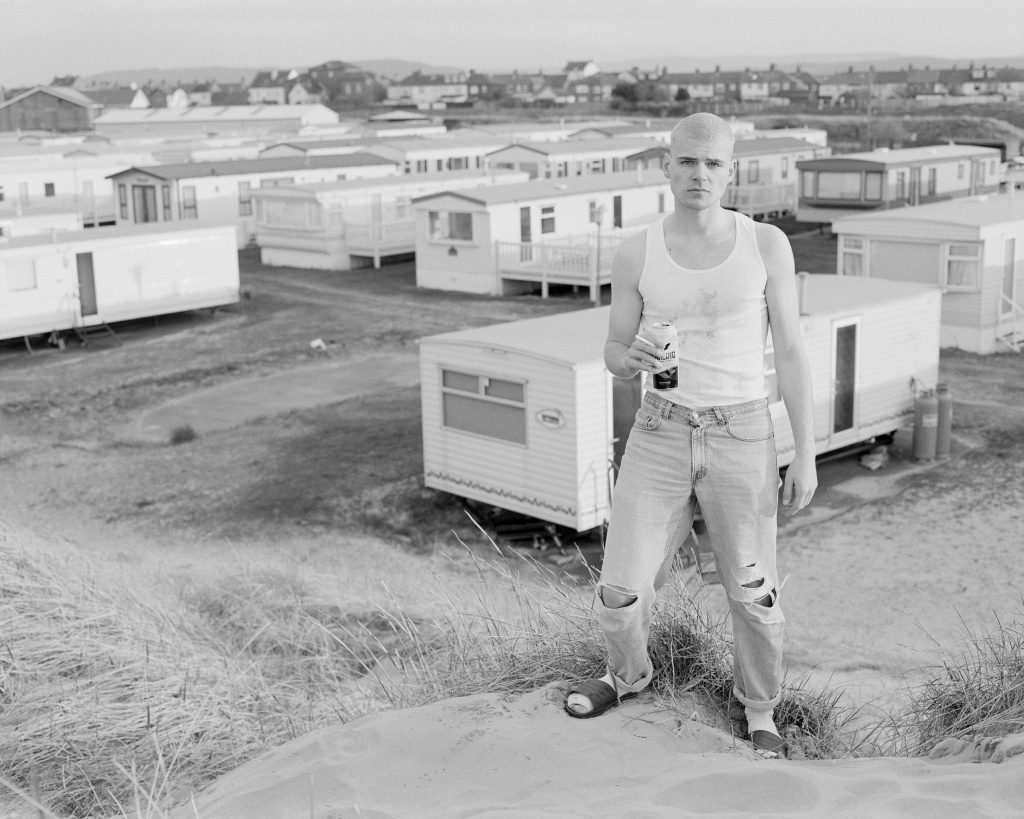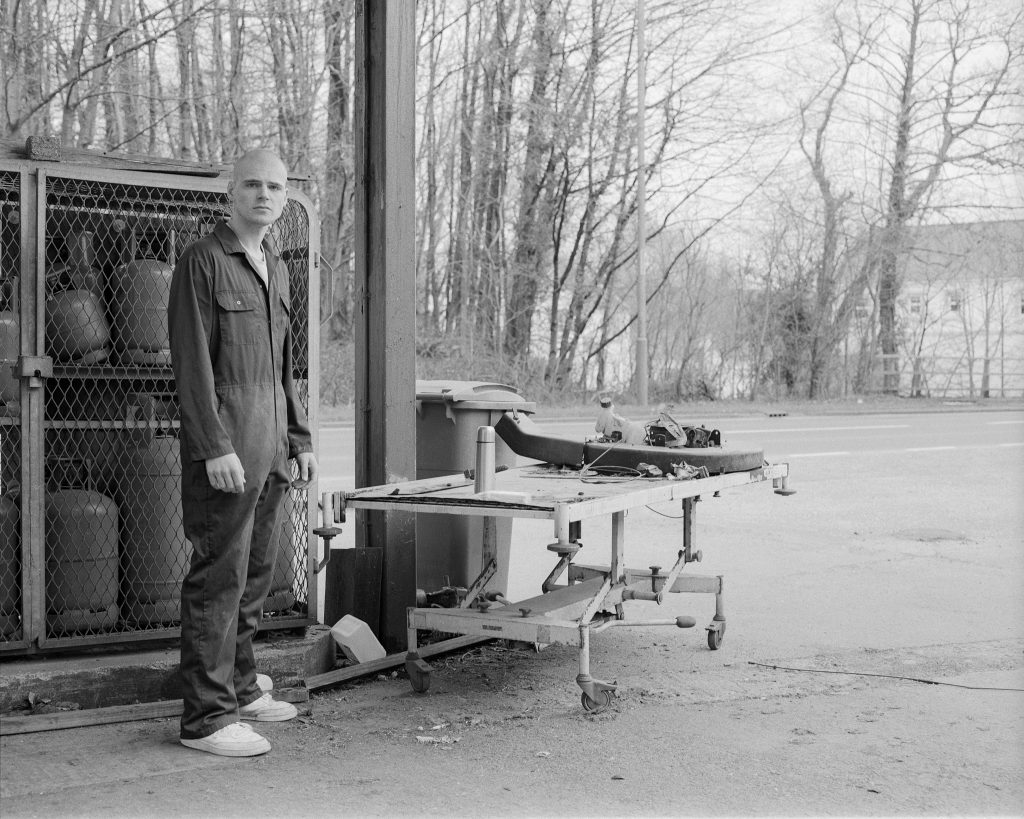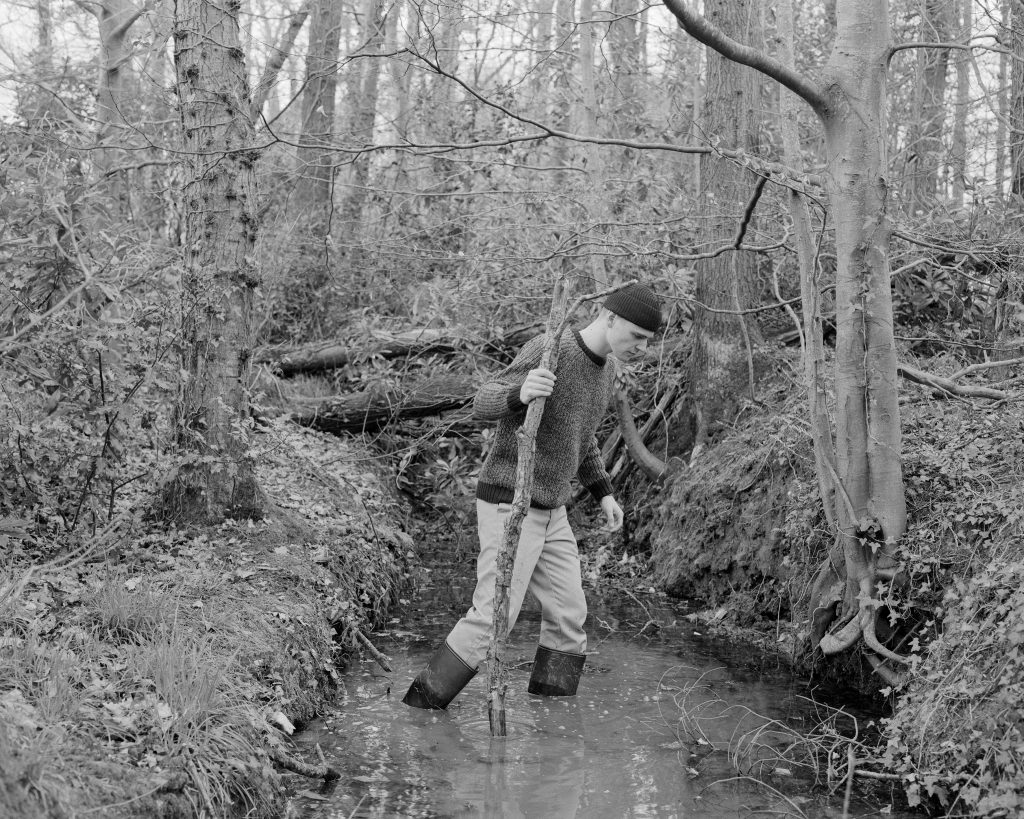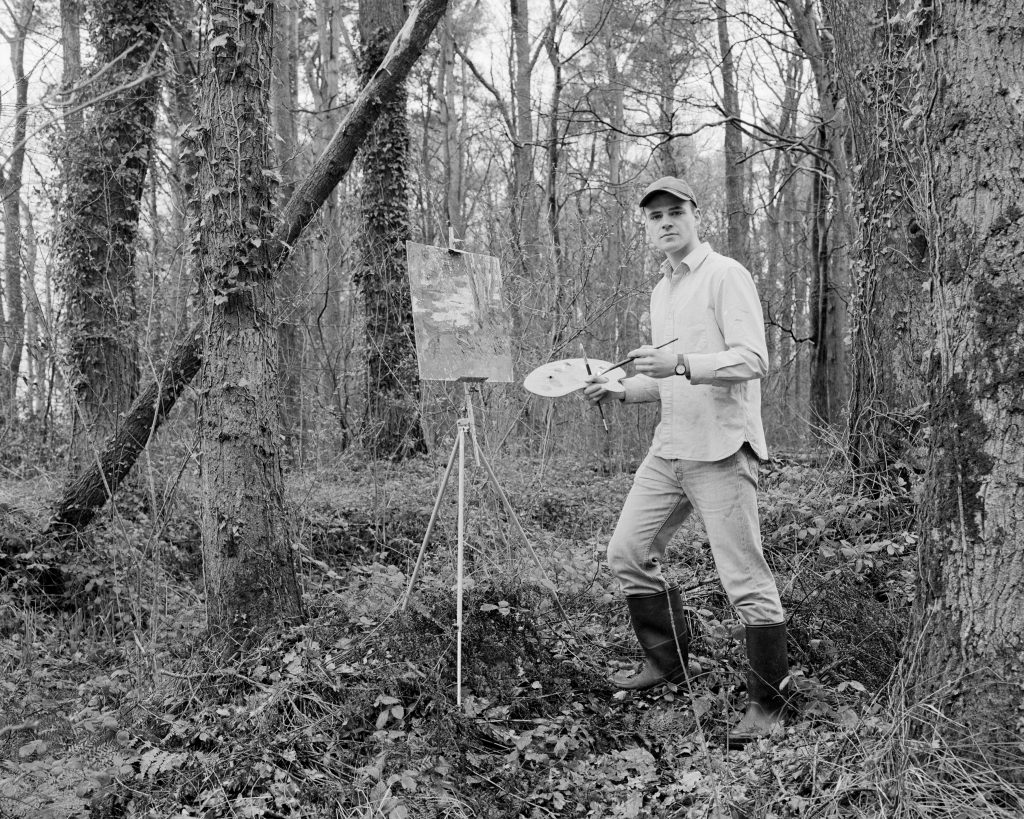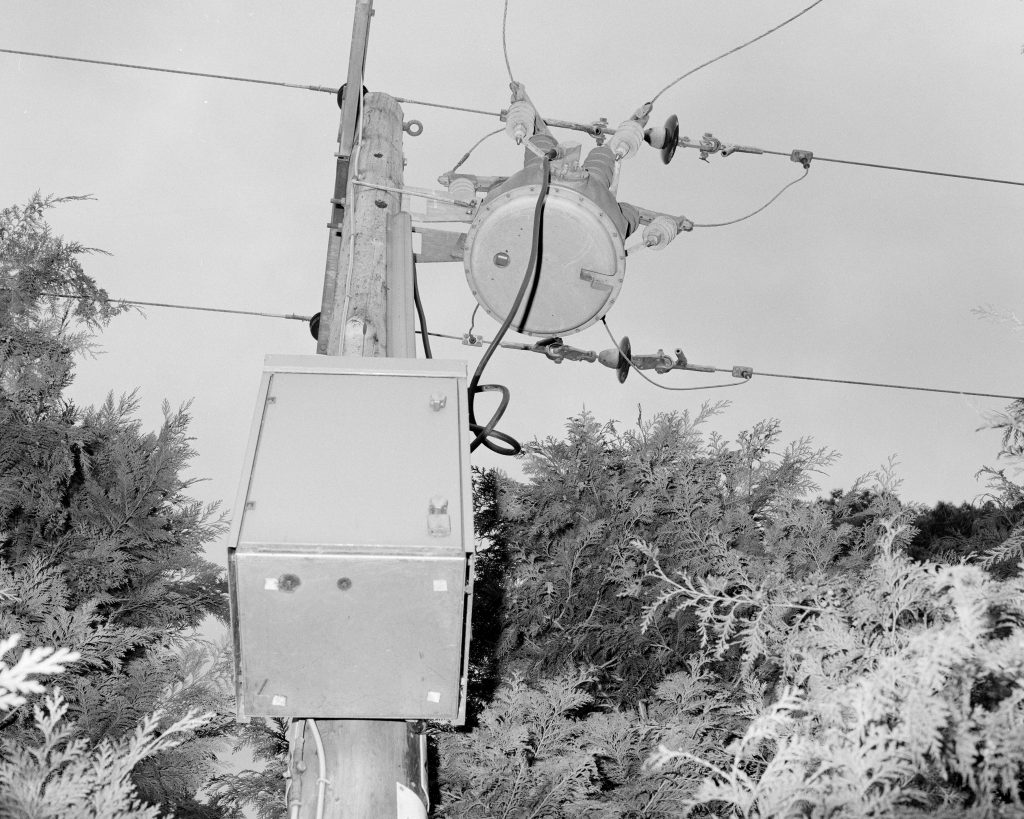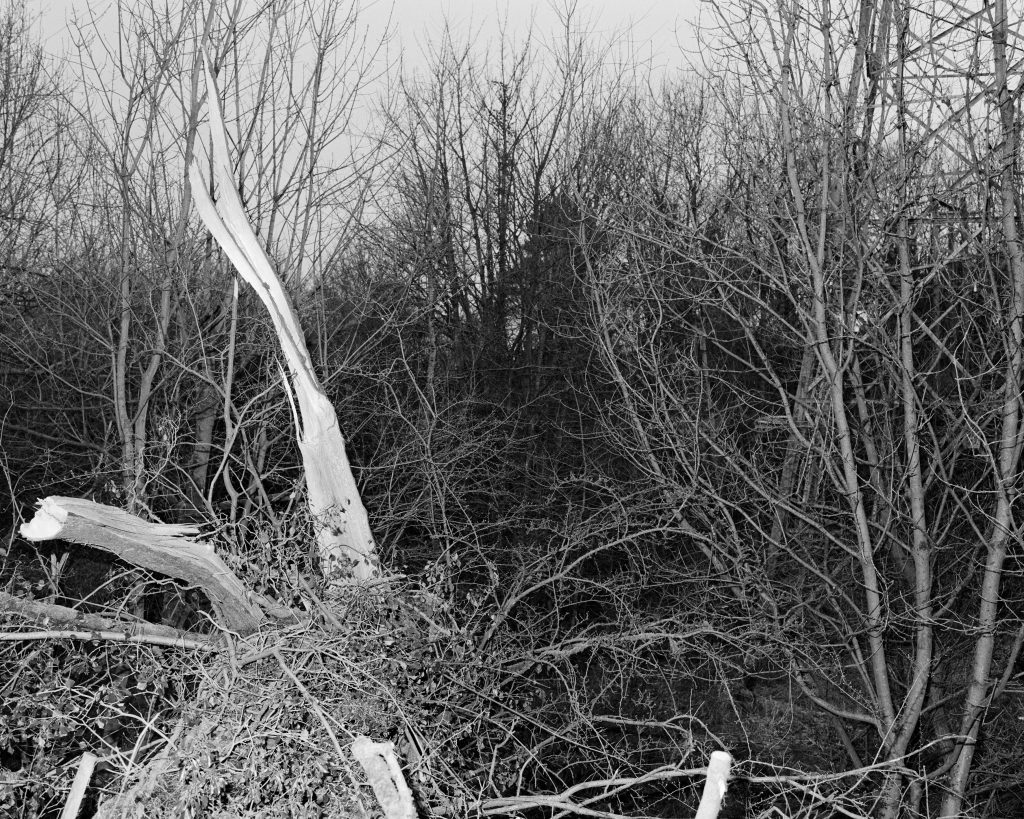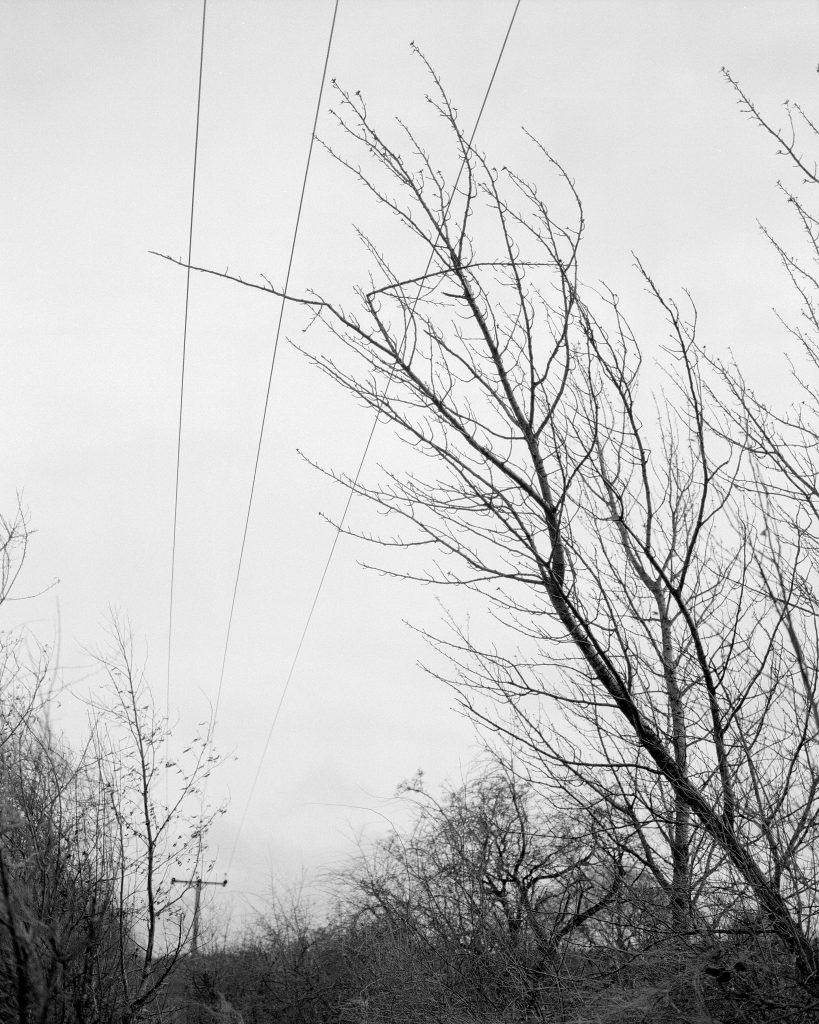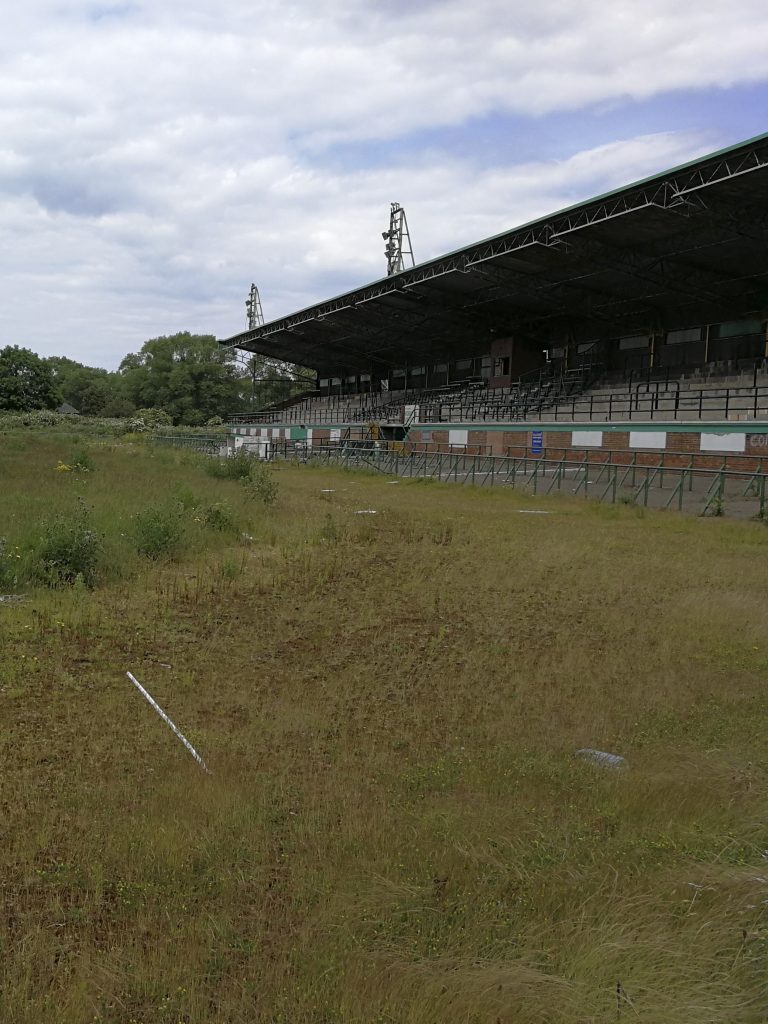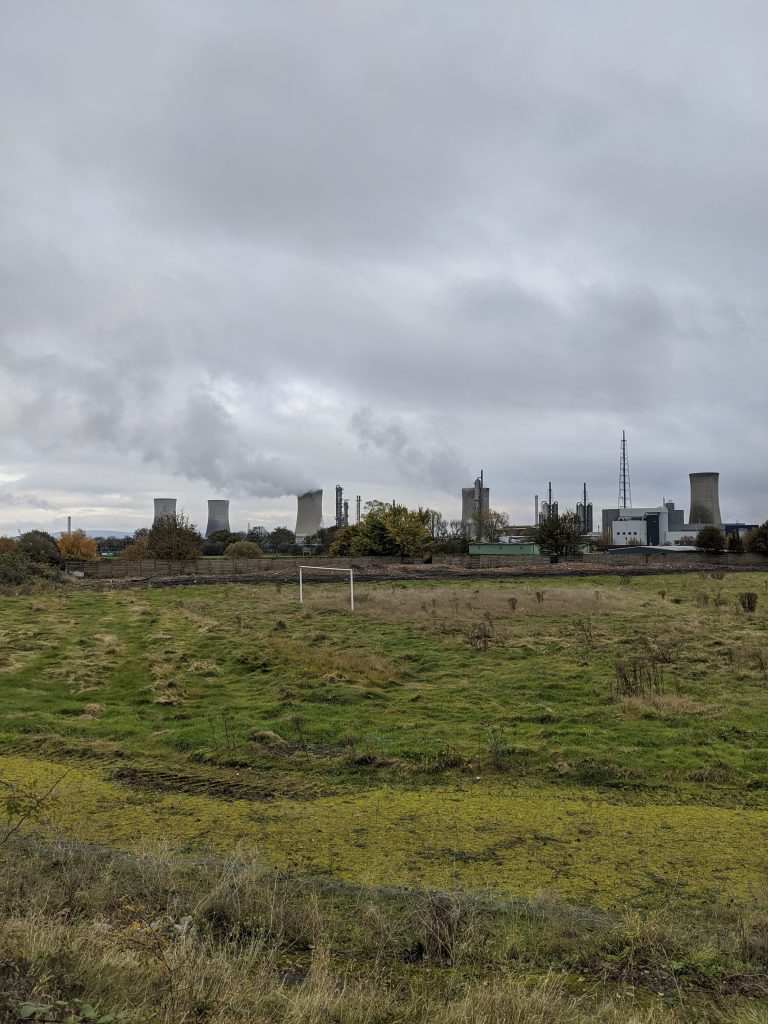YALE Online Lectures
Through my time at university we had a number of guest lectures that I had the opportunity of attending. These guests where varied across the whole industry to give us as many different viewpoints and perspectives as possible. The traditional format would be a prepared presentation given by the guest, about their work or their position within the industry, followed by a break for 20 mins, then afterwards we would return for a Q&A.
These Q&A sessions can oftentimes be dreaded by both parties. The guest for being placed on the spot for questions they are not prepared for, and for the students, to come up with a meaningful question can be a daunting task!
As a student myself, it felt sometimes difficult to come up with a question based solely on the presentation I have just seen. Most of the time it the speakers where of a high enough quality of public speaking, that their presentations where clear, concise, and easy to follow and understand. Great for a student! However, it seems it is always expected to have questions. This is to further develop a connection with the speaker, have an increased understanding of their practice, and the obvious fact that you may not have understood something they had mentioned.
Now, jumping forwards in time to my graduation from University and finding myself under lockdown and unable to progress my career the way that I had always planned, I found myself looking to YouTube for artist talks to keep my brain active and thinking of photography. This is where I found that, thanks to Covid-19, YALE university in America had been publishing some guest lectures, ( held via zoom), in full to YouTube.
The lectures in question where from the YALE master’s in fine art course, hosted by non-other than Gregory Crewdson.
Not only where the guest speakers, high level industry professionals such as: Steven Shore, Wolfgang Tillmans, and Nan Goldin to name a few, but the format of these lectures really interested me. What Crewdson had organised, along with the help of his students, was to devise a list of standardised questions that Crewdson would ask every guest. Each lecture would still have a few specific questions, relating to the individual person and their specific position within the industry, but on the whole each of the 21 lectures posted follows the same general structure and base questions from Crewdson.
The two questions that interested me most being, ‘What is your favourite part of the creative process?’ and ‘What is your least favourite part of the creative process?’.
The concept of having a list of general and open-ended questions that are suitable to ask all industry professions made me think back to the guest lectures that I had been part of as a student. I think that the ability to call up a range of questions that you have stored away, that are suitable for all guest speakers, could take off the pressure that the student feels to come up with a highly specific question, but that they can still develop these further bonds and connections with the guest.
List of Questions for Robert Adams for reference:
- What was your first aesthetic awakening?
- Who where your early influences in terms of photography while you were coming of age?
- Do you feel that in any way your work is autobiographical?
- How do you feel that your photographs have influenced the way we see the American landscape?
- Do you believe in photographic truth or neutrality?
- What are your favourite aspects of the creative process?
- What are your least favourite aspects of the creative process?
- Is there a movie or artwork that changed your life?
- What do you see as the central themes and preoccupations in your work?
- Do you every think of your audience? Who is your imagined audience?
- How has success affected your work?
- What have you learnt through failure?
- I am interested in your thoughts about the way photographs are mostly dissimulated and seen through screens, rather than the physical prints.
- What advice would you give the students in this moment of peril?
7/6/20
Website Design and Management
Today I sat down with Harry and we discussed how we where going to manage all of the submissions from everyone and filter that into their individual choices for the website. A key thing for me, as I am the man in the chair pushing the buttons, is maintaining that sense of individualisation that the physical degree show would have brought. It wouldn’t be fair for me to just choose one of the options for everyone because I thought it worked best for my work, I need to give people their own choice. To do this I have created example pages, using Harry’s and my own work, for each of the 13 different styles of gallery. Then Harry and I have drafted up and put together a form containing all the different options that people could choose from, with notes on what each of the galleries does better than some of the others. On top of this I have done further research on how to include sound to be paired with images at specific request from Joe, to do this I have drafted an example of sound and by embedding a YouTube video to give him two options I have found to achieve what he wants.
From this point onwards, Harry is going to fill the form out for his work to give me an initial run through following his choices and decision making. Then we will start accepting other peoples submissions to tier the work coming into me, meaning I do not get swamped with everyone’s work two days before deadline.
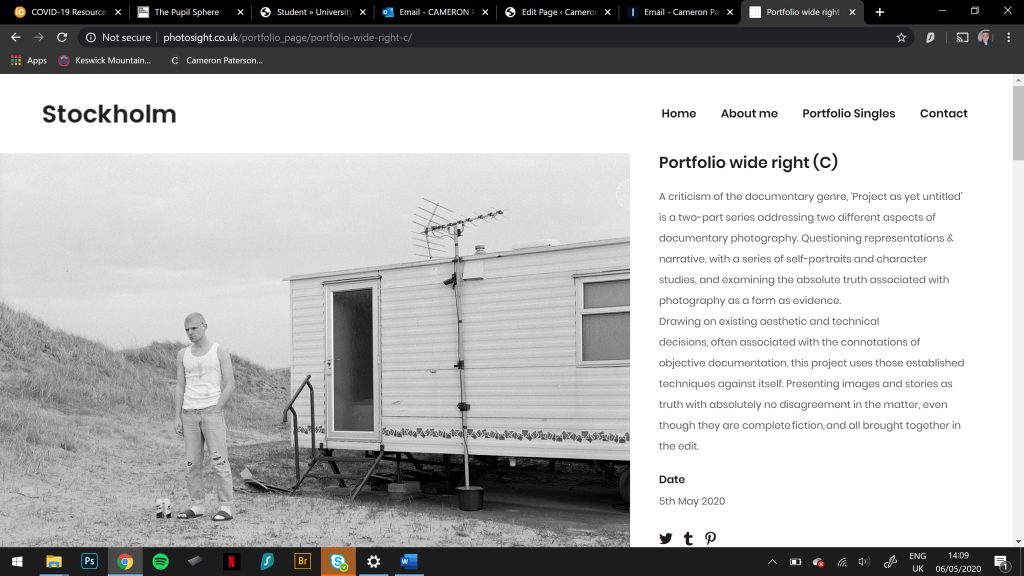
5/5/20
Pupil Sphere Interview With Wes Foster
Today I had my zoom interview with Wes Foster. I responded to questions he had about my work and elaborated off of the set of questions I had completed via email. Wes asked me everything from how my university has responded to the Covid-19 outbreak, to how it is that I decide upon a location for my photographs. This interview lasted 1 hour and 15 minutes and was an extensive and in depth questioning into my work, the themes I had been exploring and how I had gone about practically taking the images.
I asked Wes when this feature will likely to be written up and he said by the end of the week probably (10/5/20).
Once this feature is finished it can be read here:
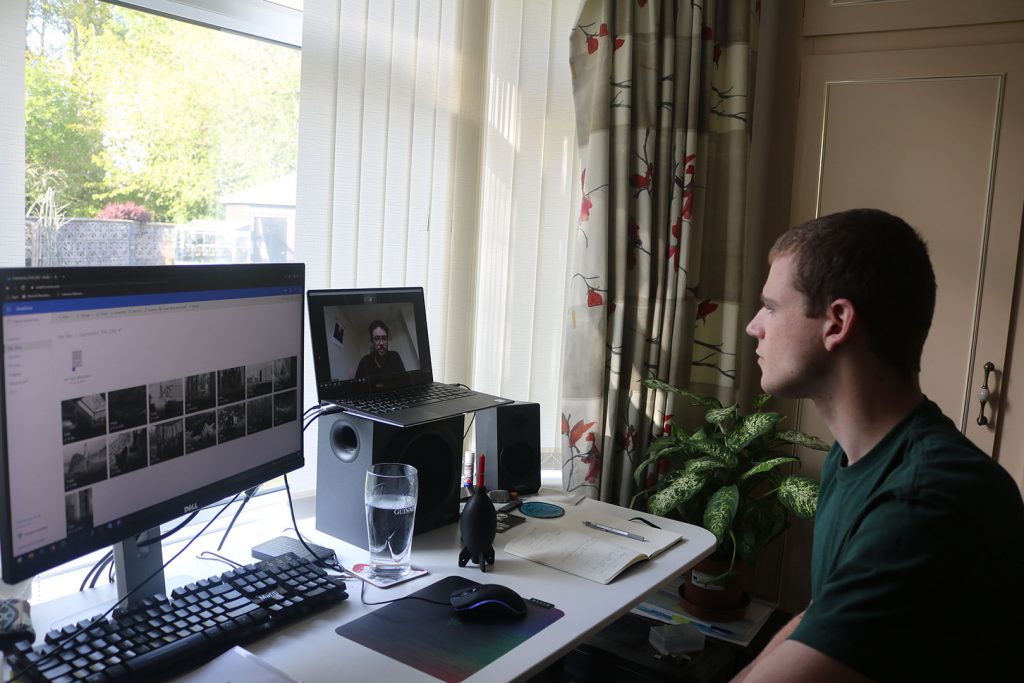
4/5/20
Virtual Exhibition Planning 2
As time goes on, I am continuing to work with games designer Stefan Rogers to create my virtual exhibition for my online degree show. Here we are in discussion and screen sharing via Discord so to get the specifics that I want, image size, location, sequencing etc.
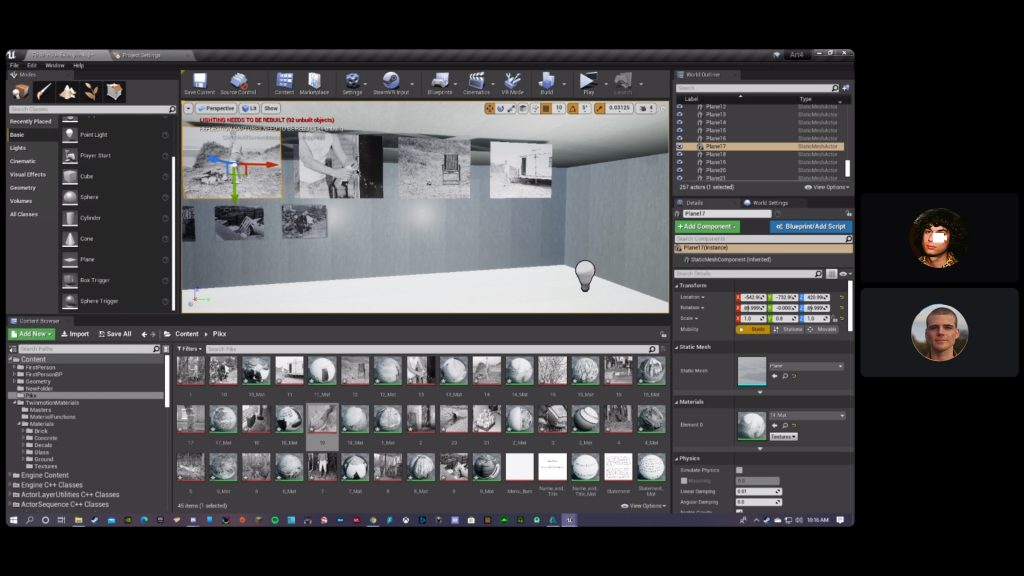
For this iteration I have selected the images in which I want to exhibit. I have chosen to utilise this virtual space and do a showcase of the whole project, rather than just one element of the project. To do this I have chosen a few images from each character to represent the work for that page in the zine, and I have selected two of the objective truth pages to be exhibited as well. We have also added the concrete texture to the floor and given the walls a solid ‘off grey’ colour (learnt from the Side Gallery visit).
The decisions that I have made for this virtual exhibition have a large cross over into the decisions I would have to make for a standard exhibition as well. This include scale, sequencing, but an important one being the flow of the exhibition. I have decided that as you load up the simulation it seems sensible to walk to the wall in front of you and follow the exhibition round clockwise. This is something that Lee from our Side Gallery visit talked to us about, he said that the majority of people will view the exhibition in the most obvious way, however you can’t stop people from viewing it oppositely. You just have to make sure that the show would work just as well from the opposite way (or implement signage if straight narrative was of the upmost importance).
My plans for future iterations of this show will be the inclusion of some better chair models, a table with an example of my zine presented on it, (however this will probably be non-interactive given the time scale), using footstep sounds to make the walking seem more immersive. Finally, formatting this game to be put on the android app store for free download as an inclusive showcase to present to possible partners in the wider field.
1/5/20
Pupil Sphere Feature and Interview
https://www.pupilsphere.co.uk/home
A few days ago, Amelia Lonsdale, the director from a site called Pupil Sphere, reached out to me via email inviting me to have an interview and a feature of my work on their site. She also mentioned that she had read on this blog about the testing of a virtual exhibition space for my degree show and she was interested in hearing more about that as well.
From receiving this email, I did a bit of research into who Pupil Sphere are. They are a network for up and coming and established photographers, and they are invested in showcasing work without the pay wall that is on many competitions in the photography world. I also noticed that Joshua Turner, who recently talked at my university, has an article on this site. Furthermore, Red Eye photography network from Manchester, has written an article on Pupil Sphere, talking about its set up and intentions, and praising the founder for his intentions.
For my own curiosity I asked how it was that they had come across my work and page. Amelia said that she had found me through a hashtag I used on my most recent Instagram post and had followed that all the way through to this blog on my website. This is actually an example of what I was saying in my ‘Instagram as a form of Distribution’ blog post I did back in January!
Going forward from this initial contact I am in contact with the writer and photographer Wes Foster to conduct my interview. Initially he has sent me an email with a few opening questions, mainly for background context before we have a conversation over zoom (or similar) about my FMP.
I will be posting a link to this feature once it has been completed on this blog.
30/4/20
Business Set-Up
As I am drawing to the end of my student life under the umbrella of academia it is essential that I start to think about how I conduct myself in the world of business.
From my research I have conducted into business I have found there are 5 types of businesses. Sole Trader, Partnership, Limited Company, Social Enterprise, and Charity. The three main points of interest for me entering into the world of photography will be, Sole trading, Partnership and Limited Company.
A sole trader is a company managed by one individual. It is remarkably quick and easy to set up and start taking payments. However, there is no legal difference between the company and the individual’s assets. This means it can be quite a risky for of business set up as your pre existing assets such as house, car etc, can be seized if there is any form of problems with business being bad and having outstanding payments. This is also known as unlimited liability.
A Partnership is very similar to a sole trader, however there is two, or more, people involved in the management of the business. It still has the risks associated with unlimited liability, however there are two parties’ assets pooled together. This can include set up costs, but also skills brought to the business.
Finally, a Limited company is slightly more complicated to set up than a sole tradership. It involves much more paperwork, registering at company house and dealing in shares. Private limited companies can have as little as one share, public limited companies instead have many shares that can be sold on the stock market and can be bought for dividends.
Due to the company being registered in a company house it has limited liability. This means that even if business goes really bad and the company goes bust, the owner will have the protection of liable assets so that their personal assets are safe.
A small limited company can be run and entirely made up of one person, the possibility of hiring an accountant might be necessary for dealing with company tax, but on the whole it is possible. In addition to this, the individual pays them self out of the company and can set this up as being a flat rate so can be a good way of keeping a regular income, rather than having a surge of income at irregular times (that can happen with sole trading).
From my research, I will be interested in setting myself up as a sole trader as soon as have a product to sell (once my zine is ready to be distributed), but I do have the intention and interest of setting myself up as a limited company in the near future to have the extra security of limited liabilities.
29/4/20
Zine Testing
As we are drawing ever closer to the end of my degree and submissions creeping up, I have been working of a book dummy of sorts, for my zine. I have always envisioned this project being featured as a newspaper style publication and I have researched this all the way back in January.
As the work is mainly finished, I have been mocking up page designs and sequencing just to see if there is anything I have needed to change along the way. Because of this, I have made many different iterations of the draft of the zine, however this is looking like the final design
The work still needs to be titled, statements to be finalised, and text to be implemented on each page, however the images and layout are basically there now.
28/4/20
Virtual Exhibition Planning
At the moment I am trying to set up some kind of downloadable virtual exhibition for my page on our degree show website. All artists have been asked to provide some kind of documentation of an exhibition visualisation for our degree. This entails a mock-up to try and convey print size and scale, sequencing and physical materials (e.g. frame etc).
I am intending on provide some jpeg images evidence as well as this endeavour. I have already produced a compilation using photoshop and editing out some work from a previous crit photograph.
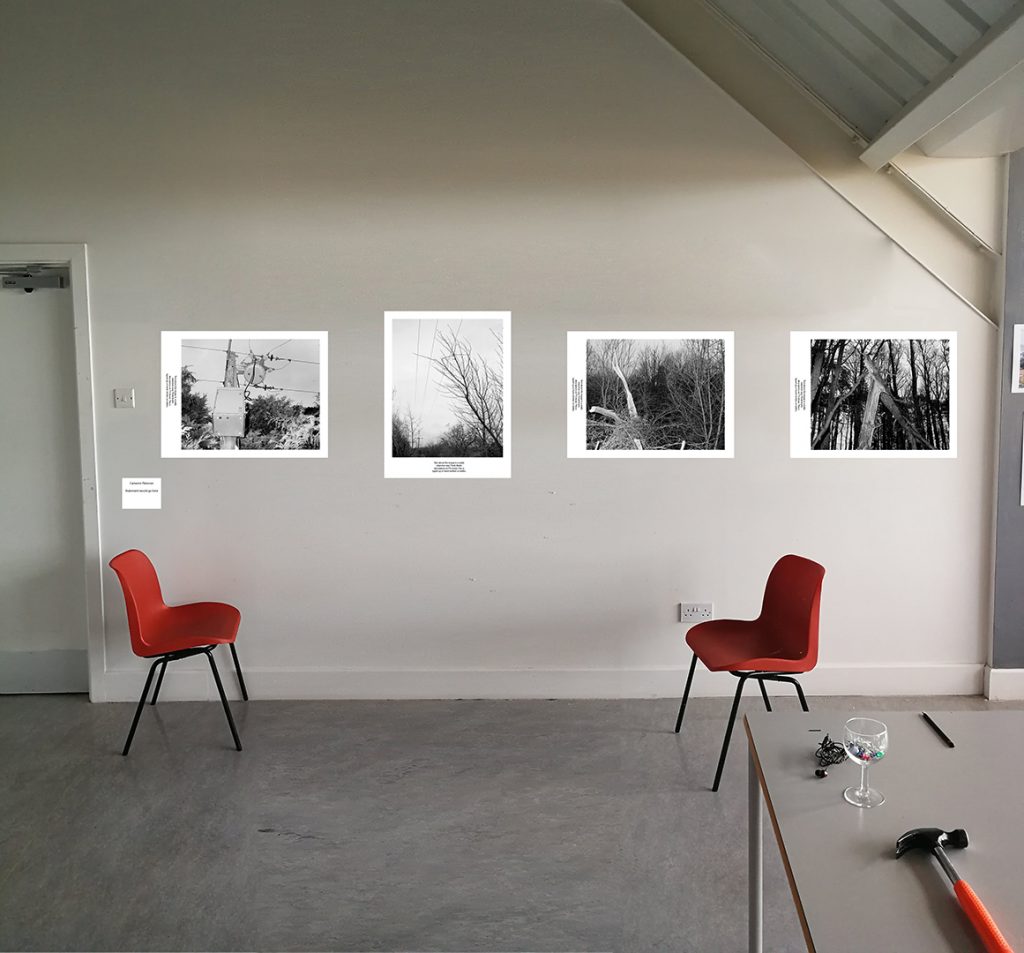
Additionally, I am ambitiously working with a games designer, Stefan Rogers, to produce a virtual exhibition. The idea behind this being to have a space in which the viewer can walk around and view my work to the exact scale that I’d of planned to have my genuine degree show. We are working towards a desktop version and we are researching the possibility of having it as a downloadable app on the google play store so that it is viewable and playable on peoples phones as well.
This version is 5 versions in, we have ironed out many problems and through online meetings have communicated and agreed on what the final product will be. With this version we have introduced some basic furniture to fill the space in the middle of the room so it doesn’t seem so empty, and we have also filled the walls with different sized images and tested how the images respond to different things.
The main decision I have to make with this tool is the ability to have my own private virtual exhibition. I have two choices, either to show as an example what I would of done as my contribution towards the physical degree show that we can longer do, or, due to the limitations of a shared space being removed, do I instead do a full showcase of my full FMP?
26/4/20
Source Graduate Online
In addition to the AOP student awards, I have organised for a group of my fellow classmates to enter for the Source Graduate Online 2020. This is an extremely important year to be represented by Source in their online archive of student photographers as many of us will be missing out on face to face networking through our degree show. To go about the submission, I have been nominated to be the lead student, so I am held responsible to submit everyone’s images all together, along with culminating everybody’s individual payments. My plan for accumulating everybody’s images is to set up a shared OneDrive folder for everybody to put their work into, that they have formatted for submission themselves, so that I can review the submissions and check they are to the specifications and upload all together.To actually be represented as a registered institution there needs to be minimum of 5 people wanting to submit to Source. We have at least 8.
20/4/20
AOP Student Awards
I was planning on applying for the AOP Student awards anyway, however I noticed an email come through from them saying that their was an Easter flash sale on all prices so I decided that this weekend was the time to get my application ready and send it off.
Looking into the categories and importantly looking at the previous winners and who the current judges are, I reckoned that the best categories for me where going to be People, (where I would submit my self-portraits), judged by Julia Fullerton-Batten, a fine art photographer…
and the place category (where I would submit the images set around a fantasy story about the power lines)…
It was a close call for me to submit these power lines images into things or place, and it came down to the judges and who would be looking at the work. For the place category it was Laura Noble, the creative director of the Laing Art Gallery in Newcastle, and the judge for the things category was Lee Smith, Director of Lucky Generals, a creative agency focusing on advertising etc. This is still a good judge and I am not disregarding them, but for me personally I would rather The Laing Art Gallery see my FMP work than an agency.
The AOP student awards are significant to my personal development as I see them as an opportunity to get my work out to the wider world. Even if I do not win anything from them, there is the fact that my work will have been past the eyes of people from within the field. From this perspective these opportunities are priceless, as there is no way I can plan for whichever competition or call for entries might lead to some genuine work later down the line.
12/4/20
Simon Roberts On Artist Residencies
Today Simon Roberts was doing a live Q&A via Instagram live. I dropped in to listen and came up with a question for Simon about apply for Artist Residencies.

This was a very useful Q&A for me because I am very interested in what Simon has to say on this topic as it is something I am intending on attempting once out of university.
View his full response in the 3 minute video below .
10/4/20
Notes From Another Tutorial
:- Consider having two statements, one at the start of the zine, one at the end.
:- For the start statement, fully buy into the concept. Set the viewer up to be strung along. Have the statements come across as genuine and along the lines of, here are a collection of studies into people I have meant across the UK. Write it from the point of view as the photographer/ journalist.
:- By having the first statement within the concept it lets the viewer experience the journey through my work without being told exactly what’s going on straight away. Leave it until the second statement at the end of the work to explain methodology.
:- Work out which concepts are the most import with the character work, currently in the latest version of my statement it is coming across as a scatter shot of ‘buzz concepts’.
:- Consider each page being individually titled, maybe as issues from different days?
:- Format of the text, where on the page? In column mimicking newspapers? Maybe as a footnote (to borrow from literature), by doing this it does not break up the format or flow of the page. Therefore, reducing conflicting elements.
:- Rob wants “Less trees more things”
8/4/20
Degree Show Planning for a Covid-19 World
So I have attended two degree show’s in the past (the two years previous to me) and one thing that I noticed was the freedom to ask questions with the artists as everyone is mingling in the same rooms. I have been trying to come up with suitable substitutes for this for our online submission and even though I know absolutely nothing will be as close I have come up with an alternative.
To mimic the idea of the opening night; those that wanted to participate could pre record a short 3-4 min video of them explaining a bit about their work and the processes behind it. This pre recorded message could then be played as a live video format with set times as to when the next artists talk is. The benefits of having the videos as a live video would be that as your video is playing describing your work, it leaves the photographer free to answer questions through the live chat function, therefore mimicking the conversational part of the opening night.
Obviously, you might be thinking, “why don’t we just have a live Q&A instead of having a talk going on at the same time?”. This is still an option, but in my experiences of participating in live video features, it is easy to just get sucked into reading comments and distracting you from what you went live to do in the first place.
I will bring this to the group tomorrow for our Skype lecture and group discussion of degree show ideas, along with the idea of using the Stockholm design for our WordPress sight.
6/4/20
Website Design
As I have previously written, our website for our degree show is being hosted on Word Press, I have gone over the benefits of this before so won’t go into this again. But as our entire “degree show” is now resting on the online presentation of our work I have re visited looking for website themes. By doing so I have found a really nice functioning group portfolio style website theme.
https://stockholm19.select-themes.com/?_ga=2.48023719.1828301252.1586788595-559517086.1586251303
It is called Stockholm and it has many different kinds of websites you can make with it, but specifically I am looking at the ‘Ylva Portfolio’ as a good demonstration of what could be done. Through looking at the demonstration it seems that there is enough customisation between how the images and text are formatted on the page from sideways scrolling to vertical etc.
It’s $69 to buy the theme but as I have stated before it is a onetime purchase.
5/4/20
River Man
Today I was out shooting for a supporting image for my painter character. The idea being to show the wellies he is wearing by the gate to the house to join the dots between him being outside in the woods and his loft with more paints in. However, as I continued walking into the woods I came across this scene which I thought would be an amazing backdrop for a new character.
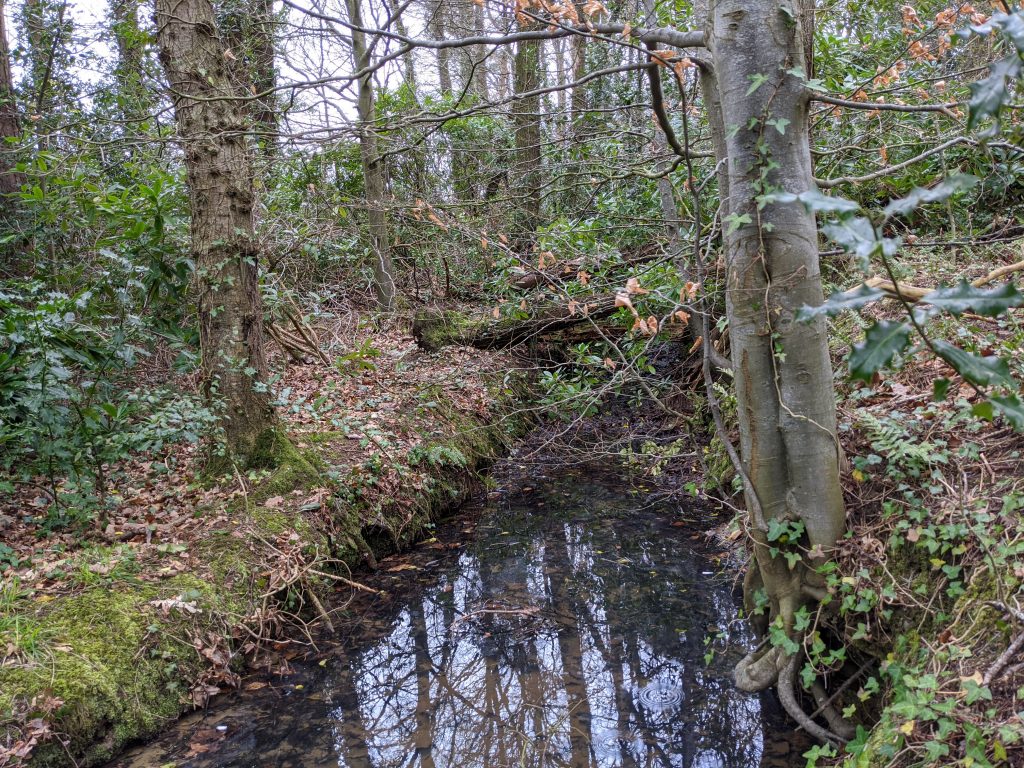
I came back inside, grabbed my notebook and made this really quick concept drawing, quick ideas of what clothing to ware that would come across well in B&W so contrasting shades.
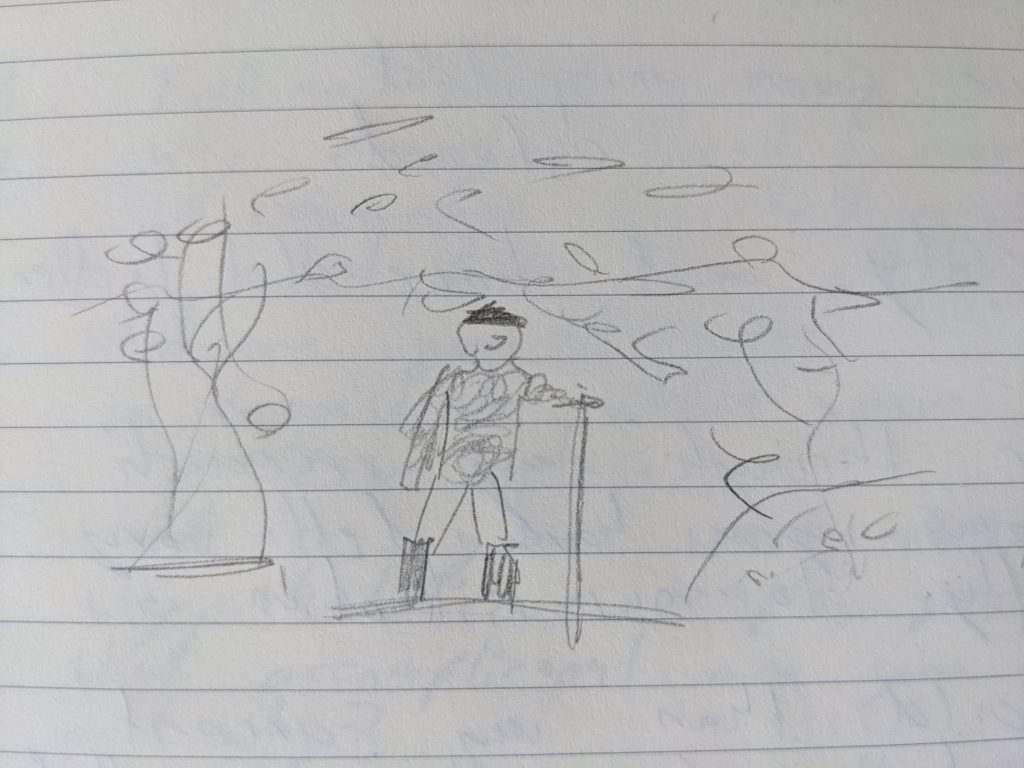
I spent a few hours wading around in the really thick mud and water posing and preparing for the portraits. I think they have come out really well and pair fantastically well with some of my previous images.
The problem is however, that I can no longer use the images of the wellies by the gate that I originally set out to photograph because now the viewer will associated the wellies with the River Man now rather than the Painter.
3/4/20
Mock Interview Planning
“Do you have any questions?” Is the most common interview question asked. Often, it’s overlooked as nothing more than them being polite, but it is actually still part of the interview. They are looking for intuition and an interest into their company if you bring a question then that’s an example of you showing that.
This being said I have prepared a question for my job interview for my position at Glasgow School of Arts for a position on their Fine Art Masters course: “You are from an esteemed university and have a lot to offer me, however, through my research it seems you have dealt very differently to the Covid-19 situation than my current university. Is there anything that you have learnt from this situation that you will be bringing forwards into future years?”
Preparing for my interview I have researched what the 10 most common interview questions are according to the Guardian these are:
- Tell me about yourself?
- Why do you want to come here?
- What are your strengths?
- What are your weaknesses?
- Why should we employ you?
- What accomplishments are you most proud of and why?
- Describe a time something went wrong and how you dealt with it
- Where do you see yourself in 5 years time?
- What motivates you?
- Have you got any questions?
By researching these up before having my interview, it means that I am prepared for the likelihood of at least some of these questions coming up. In turn this means that I will come across as a confident and suitable candidate for the post I am applying for.
2/4/20
Alec Soth Instagram Open Call
Alec Soth posted this Instagram with the most highly specific brief I’ve ever seen. This made me far too curious to ignore. Here is my response and interpretation for the brief.
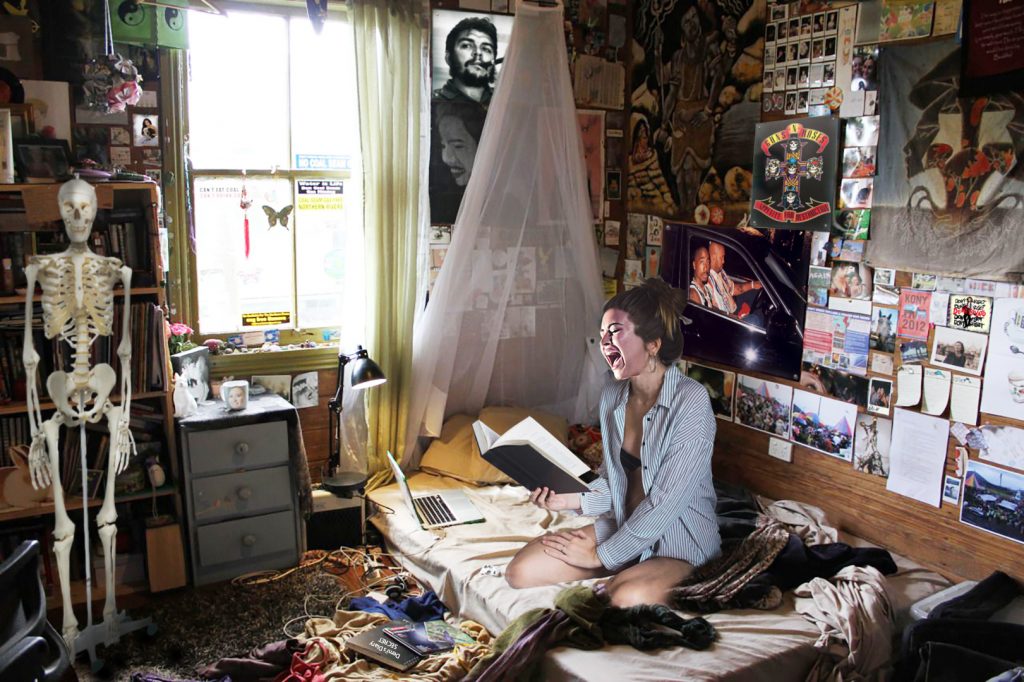
31/3/20
Epson V750 Scan & Sharpening Research
So I’m obviously lucky to have the flatbed scanner at my disposal as it does mean that I can continue shooting analogue. However, this being said, I am getting frustrated with my scans as I have been royally spoilt by the Hasselblad Flextight at uni; The Flextight produces so much sharper and cleaner scans from negatives and the Epson just cannot compete.
Because of this I have been researching into how to get the best kind of scans out of the scanner and I have found a very small and slight adjustment you can make on the scanner’s film holder. Underneath the holder there are little feet with an arrow that either points to 0 or + and you can also take them out completely (also known as – ). This is the only form of focusing that you can do and it is just slightly increasing or decreasing the film from the focusing plane. I ran a few tests scanning at each hight and found that + hight works best for me.
In addition to this I am not a fan of the Epson software and all of the automatic features. First thing I did was turn as much auto things off as I could. I scan the negative as a positive scan and use my same workflow that I do for the Flextight in photoshop for the Epson scans. However a big part of the Epson software is the sharping mask. This obviously doesn’t make the scan actually sharper, it’s actually an optical illusion where it makes all of the edges of your image a higher contrast to appear sharper. This being said the Epson sharpening mask does not leave any room for professional control. So I turn that all off and had to do some research into different post processing sharpening methods in photoshop. I found that the High Pass filter gives me the greatest amount of control of the amount of sharpening and what is actually classified as an edge.
Here is an example of my workflow for sharpening:
:- Convert image to Smart Object.
:- Apply High Pass Filter.
:- Set pixel radius to something small, around 2.5 but changes for each image.
:- Blending Mode to Linear Light
:- 70% Opacity for filter
30/3/20
Photographers That Focus on Home Environment
With the recent development in the world, limiting peoples movement and therefore limiting many peoples plans for working, the education board has developed a list of photographers that focus on the home environment to inspire us and to let us know it is possible to continue to work in conditions such as these.
Through going through the extensive list provided my favourite photographer was Jan Mccullough with her work ‘Home Manual’. I thought this piece was comical in a tongue in cheek way, made an interesting conclusion on instruction books that are taken literally. But most importantly, inspired me to keep going at home.
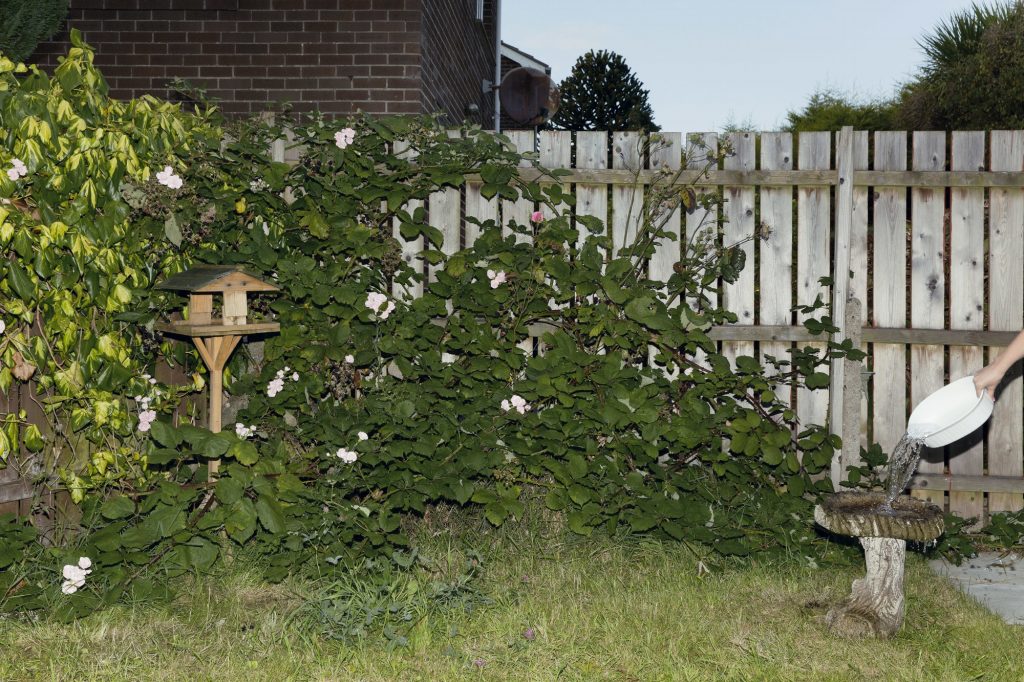
30/3/20
CV Development
The job position I am applying for does not in fact need a CV as part of their application. This means I cannot tailor it specifically to the job role; however, I have tailored it to my specialities and talked about all of my USP’s (Unique Selling Points) that lie within the field of photography. By doing this I have tried to make a CV that could be used to impress a photographer I might be in contact for an assisting position over summer for example. I have avoided crowding my CV with unnecessary information or things that might hide my strongest and most impressive achievements.
You can click here to download my CV
27/3/20
First Home Developing
25/3/20
Covid-19 Lockdown Materials
As of writing this everyone’s world has been turned upside down and everything is uncertain. The university campus has been closed and all teaching has been moved to an online format. Forms of assessment are under review as our degree show isn’t looking like it’ll be able to go ahead. This is obviously devastating for me but I also know that there will still be some form of assessment hand in at the end of this and I will still need to continue with my work. To continue working the way I have been working to continue with consistency and not be effected too much by being off campus I have borrowed a lot from the university:
:- Enough chemistry to develop 10 rolls maximum.
:- An Epson V750 pro scanner.
:- I have my own licence to Photoshop & Lightroom.
:- I’ve shot 3 rolls of film that need to be developed.
:- An additional 5 rolls of unexposed film to continue shooting and developing my work.
24/3/20
Mechanic Substitute Shoot
It seems that a country wide lockdown is inevitable and due any day now. This has given me the extra pressure to get out and shoot my final character I have planned. I obviously had planned to shoot the mechanic character in Brampton based off of my location scouting. However, this is not possible anymore, so I have to adapt and overcome this problem. On my way driving up home from my student house I drove past what appeared to be a lawnmower shop that I thought would be an effective substitute. Today I mucked up my overalls with what I could (mostly fire ash), shaved my head bald, and drove down to Minishant to spend a few hours on this shoot.
23/3/20
Plans for Trailer Park Supporting Shoot
Due to Covid-19 I am now no longer able to travel back to where I shot the trailer park images. This means that my plans to re shoot the chair and some more supporting images has changed a little.
For now, the best I can do is shoot the cooking something image in my own student house before moving back home.
My plan is an over the shoulder shot of cooking something greasy on the stove. Make sure not to clean and make it look grimy and unpleasant. Pose in the same vest and maybe just underwear but I’ll have to crop out my head as I no longer have the same hair style.
17/3/20
Job Role Selection
I am choosing what job role to apply for today and I am considering what route I am interested in taking after my BA is finished. Ultimately, I am interested in teaching at further education, but I think that will be a few years down the line for me. This is because it is essential for lectures to have a MA or PHD, in addition to a teaching qualification. On top of this, I also think it is important for a lecturer to have experience within the field of work. It is because of this that I don’t actual want to immediately go into teaching; If I did, I don’t think I would be giving the students justice without first getting my own experiences to bring o the equation.
It is my plan to take a year after my BA to apply for artist residencies and open calls, also spend some time assisting for some established photographers (as I think I would be useful to them as an addition due to my specialist skills). By spending some time in the field of work I think this would not only give me the ability to bring more to my MA once I have applied for it, but also further connections and opportunities to bring to a teaching role further down the line. An example of competitions that I will be interested in applying for will be Source student awards and also the AOP Student Competition.
In general, a common reason for people to study for a masters is to develop a personal interest. Because of this I have been told to come to do a masters once you have an idea of what it is that you intend to get out of it. By doing this, I would be able to streamline my learning and focus one hundred percent of my time researching and developing into this idea.
What will a masters actually do for me? It will increase my employability by placing me into the high-skilled category of employees. This means I will be more suited to a professional role/ managerial role. Although, this is not so specifically related to work as a practicing photographer, it will most definitely be essential for my pursuits into the higher education workplace.
Because of the amount of qualifications, I am lacking to straight apply for a lecturing job, I have decided to apply for my MA at Glasgow School of Art for this assessment. This is an institution that I am genuinely interested in applying for, so this assessment will be helpful in practicing for that. The reasons I am interested in GSA is, the location, the reputation of the establishment, and the physical space that is given to the MA students. The MA students are given the use of a private studio space each, so that they have the ability to have work permanently on the walls and use in any way in which they see fit.
12/3/20
Tutorial Conversation Notes
:- Layout and scale are going to be important for my zine. Imagine a double page spread and start playing around with different formats with thumbnail sized work prints.
:- Is it a documentary maker looking in at someone else’s life? OR a self-documentary from the characters? (I would then be taking part in my own photo essay)
:- For degree show consider prints sandwiched in Perspex
:- More work needed, focus on more human elements, rather than just straight portraits all the time. Build the picture that these are genuine people. For example: Chair and beer in the sand; cooking bacon or something equivalent on a stove to show as inside the trailer for Trailer Park Guy. For the mechanic I’m planning, consider the greasy boiler suit in the back of the car at the end of the day.
:- Definitely have 2 channels of work. Portraits and objects & places.
:- Writing is going to important for this work. For the people consider writing in 1st person, as the photographer what was the story etc. For the other work be more objective and descriptive.
11/3/20
Peer Review Notes
Slightly confusing to follow my ideas. The two types of images are jarring and not flowing to get my ideas across smoothly.
Could I use the same body of work for 3 different questions and criticisms?
3 Chapters for different ideas?
There’s nothing stopping images repeating in different chapters and being repurposed for different questions. :- Look at Larry Sultan, Evidence. (this is more in relation to the things I find aspect rather than the self portraiture)
10/3/20
Josh Turner Notes on Kickstarter
:- Have a mission statement
:- Have calendar-based appointments for promotion, spend a few days setting up all of the posts to automatically come out.
:- Get it in: Local Papers, Radio and related Podcasts
:- Post at least one thing every day for 21 days (or the duration of your campaign)
:- Josh reached his goal within 22 hours and because of this he made it onto the “projects we love” page.
:- Share degree show with @PhotoGrad and @Spectrum, for promotion on Instagram.
3/3/20
Josh Turner – Guest Lecture
Josh Turner was the runner up for a competition run through Red Eye. For running up he had a printing session with Rob at our university and as an exchange Josh gave a talk to us about his work. Josh had two projects he mainly talked to us about:
Catch Your Breath – a project he shot in Venice on a residency. This work was about his personal feelings to the city which he found unpleasantly busy and claustrophobic and anxiety inducing. For these reasons he decided to focus on the areas of Venice that where less populated. These may be just off the main street or just a little further from the main tourist areas, but he found solitude in these quieter places.
Our Summer – It was this project that Josh was having printed. This project was an elaboration from his FMP (Still fresh in his mind as Josh is only 3 years outside of his undergrad). Our summer is about “the intricacies and tensions of childhood, and the looming burden of responsibility in adulthood.”. This work interested me greatly as Josh talked about objectivity and subjectivity and creating his own documents which are similar themes as to what I’m interested in. He talked about the image of a school test he did with his answers and working out on it. He went on to say that the working out and filling out was staged, but that the test itself was real and that he had done that as a kid. There was no problems with this for him as the test itself is the same test and what difference does it matter if he actually did do it in school or not? It still represents the same things.
Josh mentioned some of his research which was useful for me as well. He categorised them into two groups. Artists that look at objectivity…
:- Yan Wang Preston
:- Tim Knowles
:- Michael Iwanowski
… and those that look at subjectivity,
:- Jack Latham
:- Christian Patterson
:- Chloe Dewe Matthews
3/3/20
Character Design
How to make my overalls look convincingly worn and used?
:- Machine wash them a LOT, take out any shine from being bought new
:- Rub dirt & grime into the thighs and belly, also use concrete and dust from the floor.
:- Worn knees
For the grime in my hands?
:- Try powder paint – Brown paint and washing up liquid?
:- Get it into every crevice of hands as well as all around nails.
28/2/20
Darkroom Printing
Today was a printing day for me. I have done extensive printing in the darkroom before and I am experienced with different papers and films, however today was a new one for me, I’m doing some test prints to consider how this paper will do for printing my FMP on. This paper is however, much more expensive than standard resin coated paper so I’m doing some 10×8 Inch test prints before buying the larger 20×24 Inch paper I want to do my final prints on.
Printed on: Ilford, Multigrade Fibre Based Warmtone Glossy
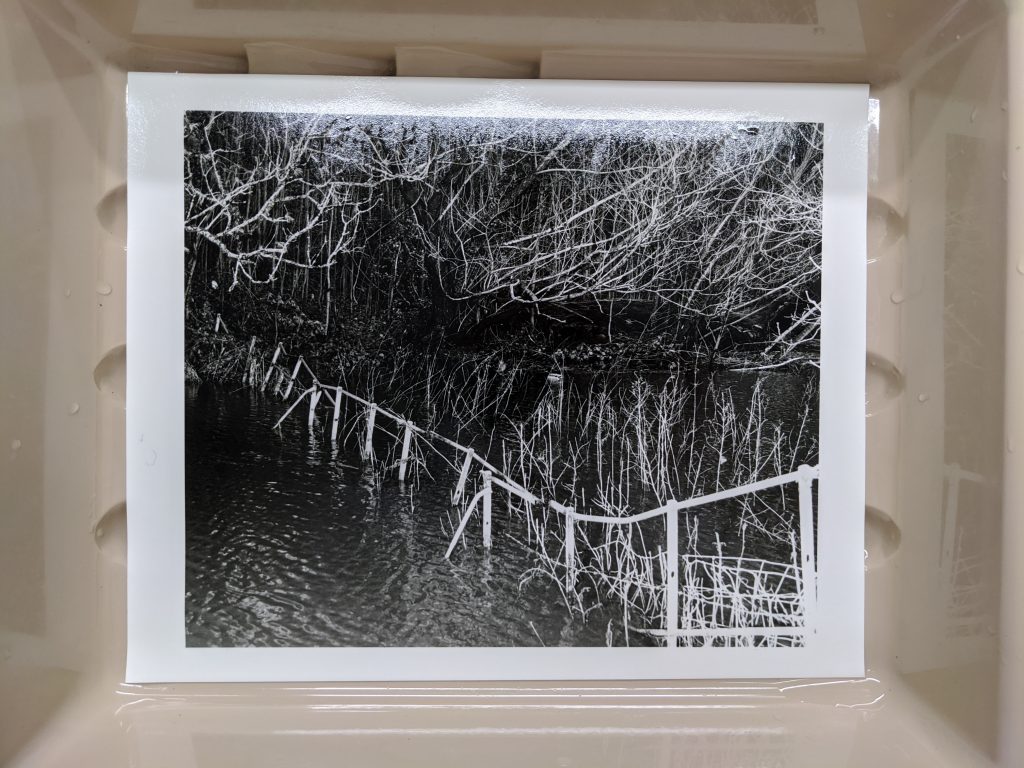
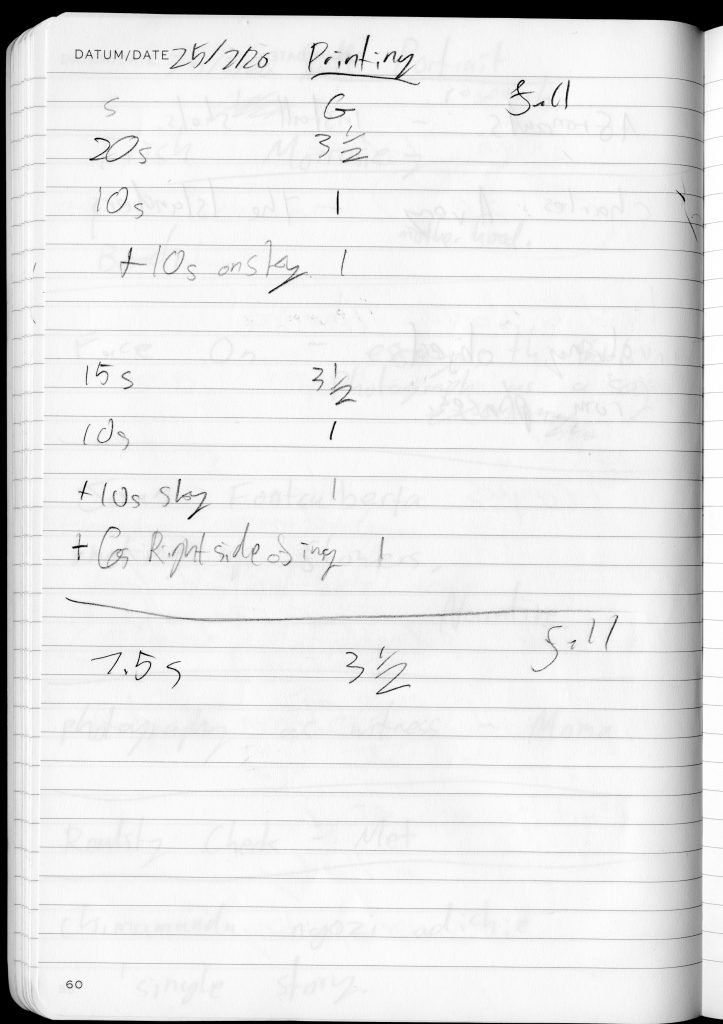
Aaron Schuman
Today I have had a lot of initial artists and essays suggested to me that I should look into for research for my FMP. One of the photographers that grabbed my attention the most is Aaron Schuman and his work ‘Slant’. His work is responding to some newspaper clippings he found in a local newspaper that are police reports, of people calling in about small stuff, mostly not needing any action from the police. His work, whilst not directly in relation to what is said in the reports, is meant to induce the same kind of feelings, and leave the viewer wondering if they are scenes from the incidents or not.
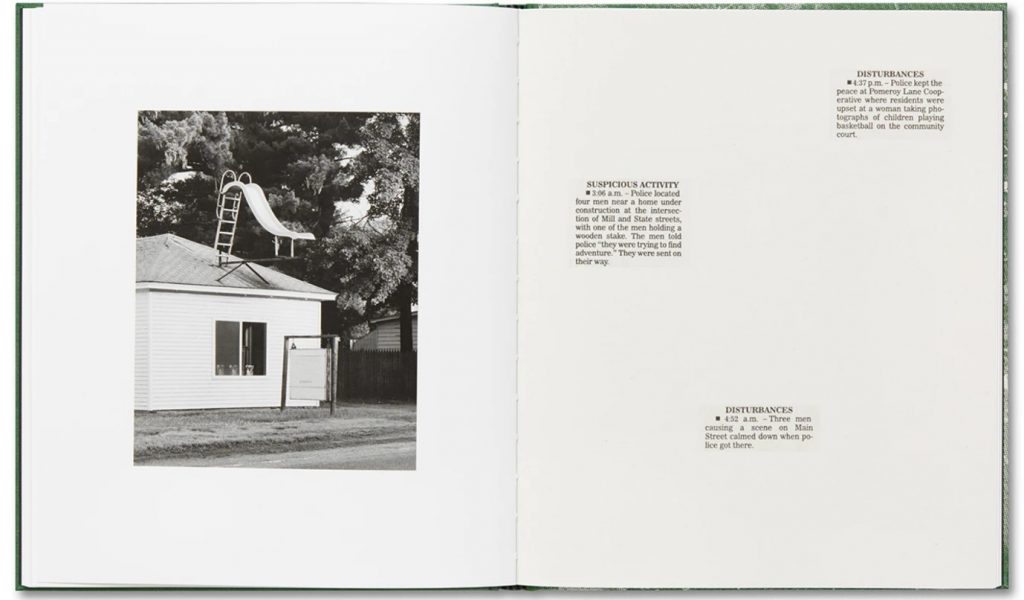
Other artists I have looked at include:
:- Trish Morrosiey – Seven Years
:- Joan Fontcuberta – Fauna
:- Cristina de Middel – Afronauts
:- Charles Avery – The Islanders
:- Susan Lipper – Trip
:- Chimamanda Ngozi Adichie – Single Story
:- Face on – Mark Durden, Craig Richardson
:- Inside out – Abigail Solomon-Godeau
:- Format 2019 catalogue – Mutable/Multiple
25/2/20
Side Gallery Visit
Today we had a cultural visit to Newcastle where we visited the Side gallery and the Baltic. This post will be a collection of notes I took from an in-depth talk and introduction we had from Lee, one of the management of the gallery.
Presentation of the images on the wall matches the subject and flow of the images is vital to this. Scale can also contribute to the flow of the images, it can break flow intentionally, emphasise importance etc.
An example of this is Tessa Bunney’s work from Vietnam whereby she followed an illegal fishing route down a river. The work is then shown on the wall to appear to ebb and flow along the wall echoing the river itself.
Another key fact is ordering of the work. There are two key ways to show the work. Linear to book order, or non linear to book order. One reason that the photographer may choose to show the work in a different order to how it is presented in their book is because in a gallery you see all of the images together. In books the images are seen in isolation. This can change narrative or context being transitioned to the wall so it is something key to take into consideration.
Most people will view the work from left to right as it is natural in western parts of the world to mimic how we would read a book or text. This is key to consider for our degree show and exhibition planning on a whole.
Standard hanging height for prints is about 135cm from the floor to the centre of the image.
18% grey is a good neutral colour for the walls for exhibitions as a nice alternative to pristine white walls, however this may not be an option for our degree show as it can be quite difficult to get the walls back to white afterwards.
21/2/20
Location Scout
Looking for a petrol station similar to that of in an Edward Hopper painting.
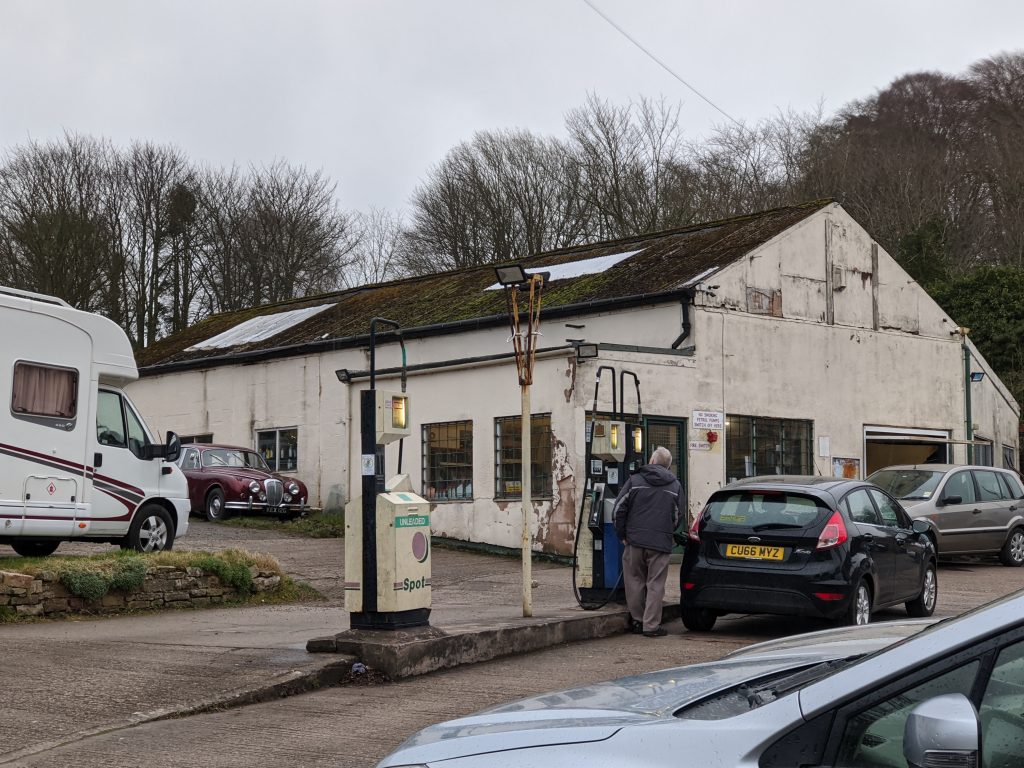
This is Sands Garage, in Brampton, not so far from my University. This could be perfect to stage a self portrait, however every time I visit it on location scouting missions it seems to have a roaring trade and is never quite. This means for me to pose and spend a good amount of time I’ll have to visit either early in the morning or late at night.
20/2/20
Notes on Self Portrait Ideas
Take influence from Edward Hopper, Gas, Four Lane Road, Morning Sun?
Different character ideas:
:- Bleach blond hair? White vest, Ear piercing, Cigs, But end jar, Mullet?
:- Fisher? Fishing trousers, Wellies, Lobster pot
:- Lumber jack?, Flannel shirt, Boots, Axe
:- Builder? Carhart jacket, Highvis jacket, Bacon Roll, Helmet
Play on and accept the use of stereotypes as that’s often what documentary is looking for and stereotypes are often just characters of the truth rather than figments of fiction completely.
19/2/20
Notes On My New FMP Project
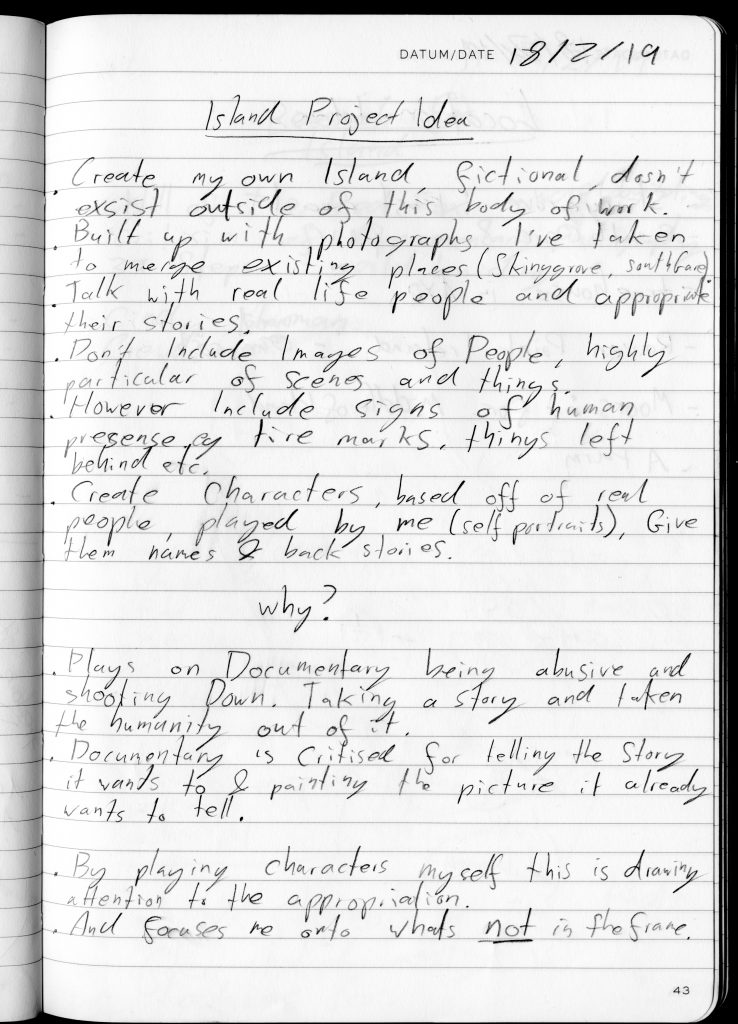
18/2/20
Everything Changes…
Today during Tadhg Devlin’s guest lecture we had today he mentioned that he had looked at the dying fishing industry a few years ago and this is what my FMP was meant to be on as well. So I started to think well if its already done, what more could I bring to the genre or subject matter and I felt completely and utterly uninspired. This sent me on a bit of a spiral of creative thinking, (also known as daydreaming and writing it down afterwards), about a completely different idea that is almost the complete opposite of my documentary piece on South Gare.
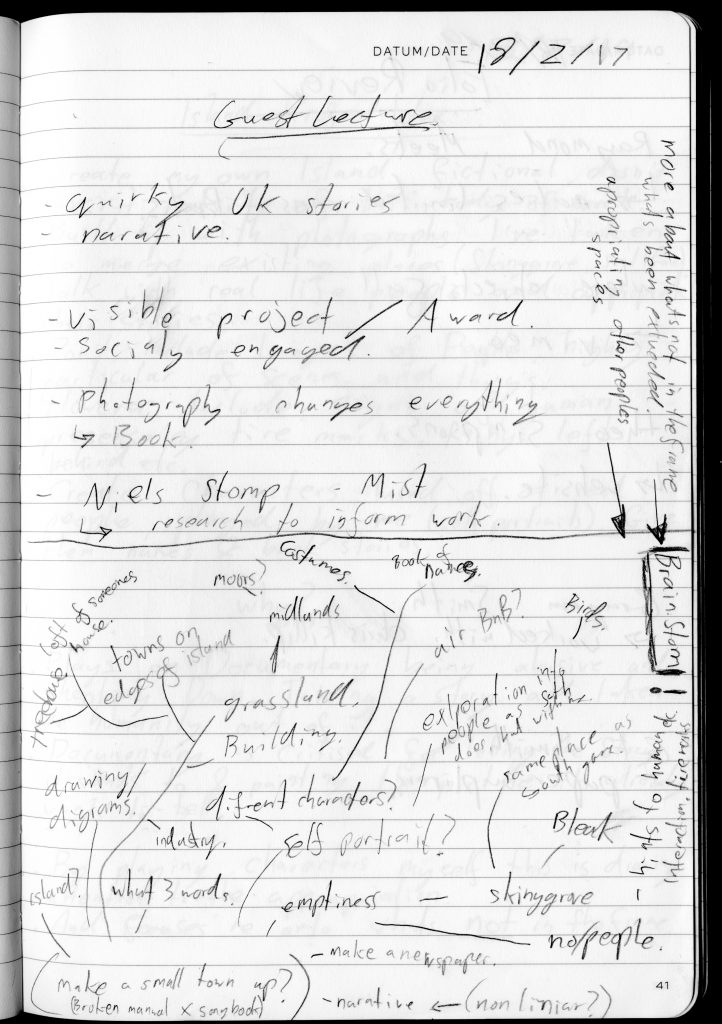
18/2/20
Exhibition Materials Lecture
:- Alec Soth digitally prints, mounts onto dibond, and then floats in box frames. This is an incredibly pricey option but will look extremely striking.
:- For my project I am thinking of hand printing my images onto 20x24inch black and white silver gelatine paper in the darkroom. My options are for resin coated paper which is cheaper, or fibre paper which can give much richer and deeper blacks, however, is much more expensive.
:- Further options I have found for outsourcing the production of my prints for the degree show are Rapid eye in London, Chris Cook is their resident printer. Or there is also Spectrum, a Brighton based photo lab. However, these two labs mainly focus in colour prints and using c41 negs, I’m currently thinking of doing black and white prints so a more suitable lab might be Lighthouse Darkroom, also based in Brighton.
:- Outsourcing the production of my prints has both positives and negatives. On the plus side, by paying to get someone else to print my work for me this leaves me with a lot more time free to work on other aspects of the degree show/ further developing my portfolio with the possible creation of a zine of the work, and as the process of darkroom printing can be extremely time consuming and complicated this would lighten my workload significantly. However, by letting go of reigns of the production of the prints, I will loose some of the creative control to get the prints just exactly right, and even with the best precautions, might just end up with what I get given by the printers.
:- Furthermore, a necessary consideration of outsourcing the production of prints is the price associated with it. As darkroom work is in itself a niche and skilled marketplace, this process is quite pricey, and only goes up with the more control and input you the photographer wants into the production. These decisions of how much contrast or exposer each part of the print needs are at the printers discretion.
14/2/20
Website Planning
I have taken on the roll of setting up our website for our degree show. Through personal experience with setting up my own website, I know it is cheaper long term and much more money wise to buy your domain name independently of a website building company such as square space. Due to this I have bought www.photosight.co.uk which cost me £1 for a year and then £10 a year for every year after that I want it active. I can host it through my dad’s network as he has space on his professional network package which means that we don’t need to pay anything monthly for a web server to host our site.
This leaves one last possible cost which would be a theme for our sight. The advantage of getting a theme means that it removes the element of coding and gives a much easier interface for us to be able to input our images and gives us our website with less complications. There is a cost associated with buying some themes, however this is a onetime payment which means once the website is set up we can leave the website up as a archive and as a permanent addition to the internet without monthly billing. Also there are free themes available as well which are more than competent and worth researching into.
The themes I have researched into for WordPress are as follows:
:- Azalea – $75
:- Timber – $75
:- Oshine – $59
:- Stills – $54
:- Photosy – $59
:- Portfolio Lite – Free
As of right now I have downloaded Portfolio Lite as it is free and have exploring whether this would be good enough for a group show of our work.
12/2/7
Glass Hire
From my past experiences of going to exhibition private views and opening nights I think that it really does make a difference if the drinks are served in glasses rather than plastic tumblers. Because of this I have looked into glass hire from different supermarkets and catering companies. The best option seemed to be Morrisons as they stated that glass hire was free on their website.
I decided to follow this up by going into the supermarket and enquiring. They said that it was a £20 deposit with a £0.50 charge per glass broken or not returned. I asked if there was any terms and conditions of the glass hire in terms of ‘you get 10 glasses per 1 bottle of wine’ but they said that they used to implement a system like that, however now all we would have to do is show a receipt of some alcohol purchased at that morrisons but there was no minimum purchase to qualify for glass hire.
I booked in for 100 of wine glasses, 100 pint glasses, and 100 tumblers for the 29th of May which was months in advance of anything else they had in the diary so no conflicts there.
12/2/20
Shooting Film with Flash 2
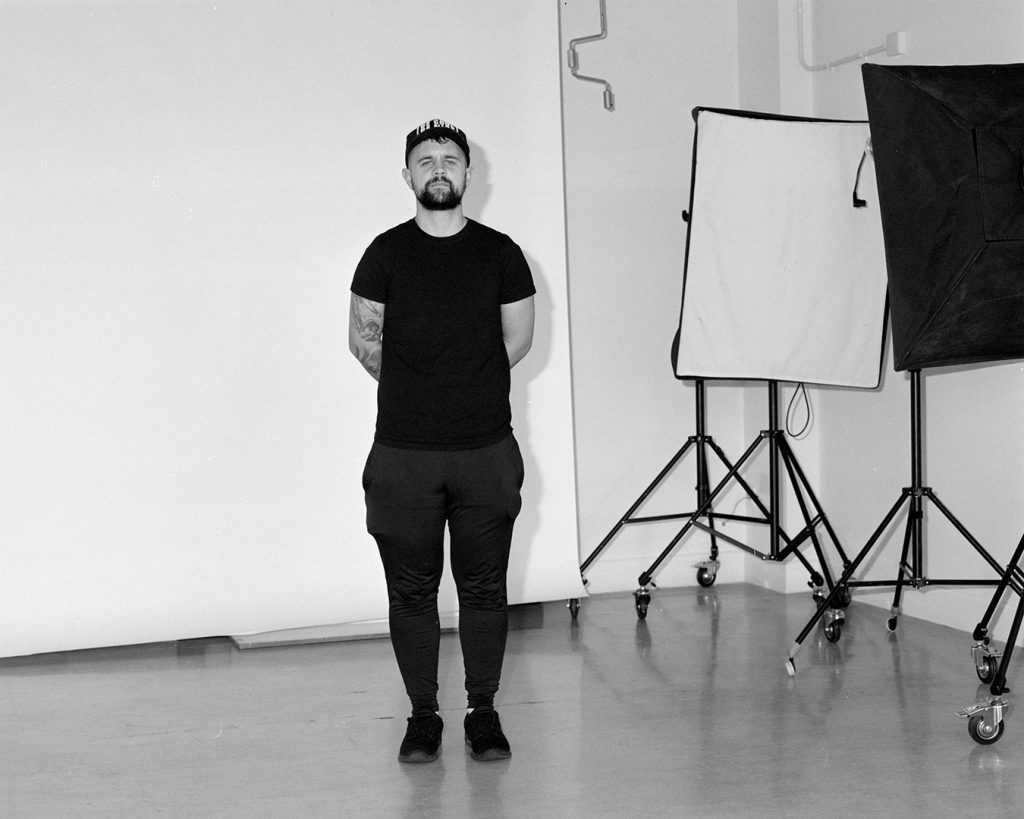
Flash: f2.8 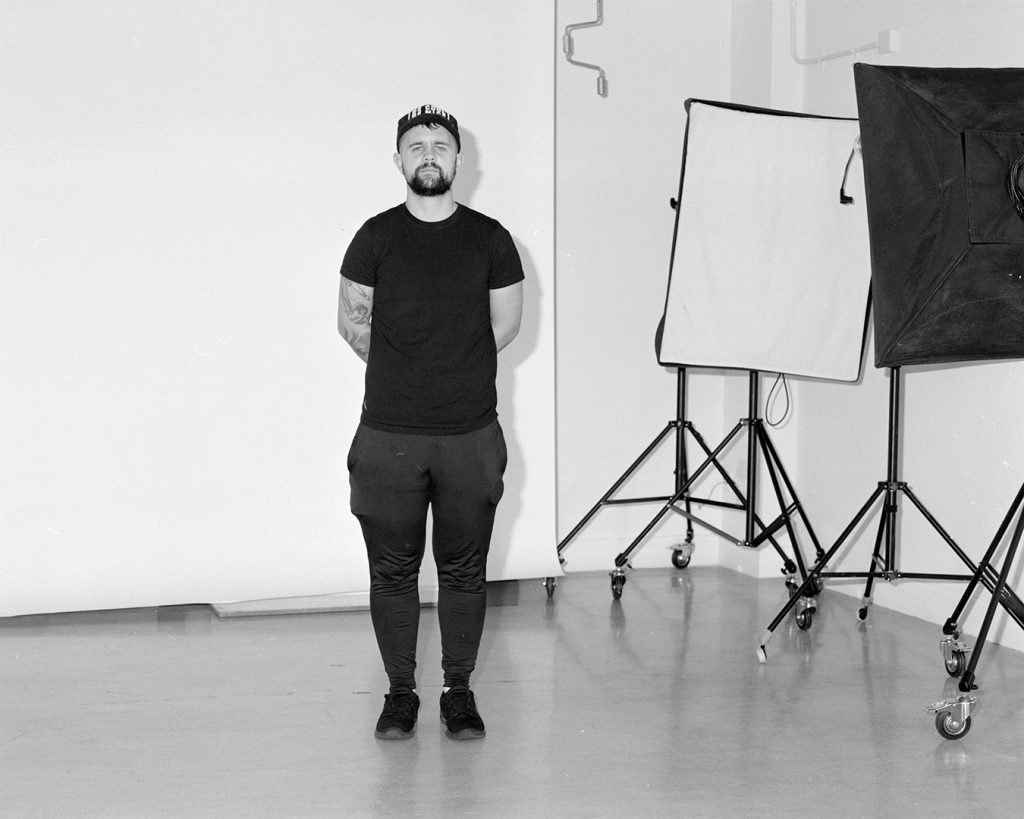
Flash: f4 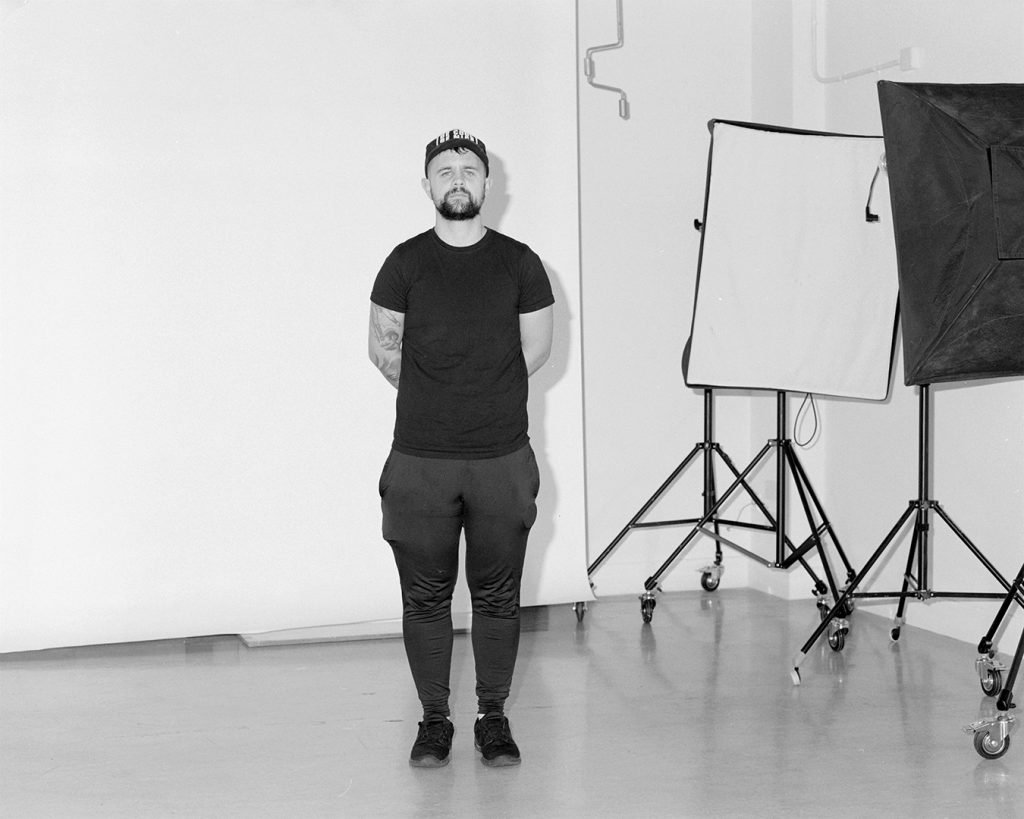
Flash: f5.6 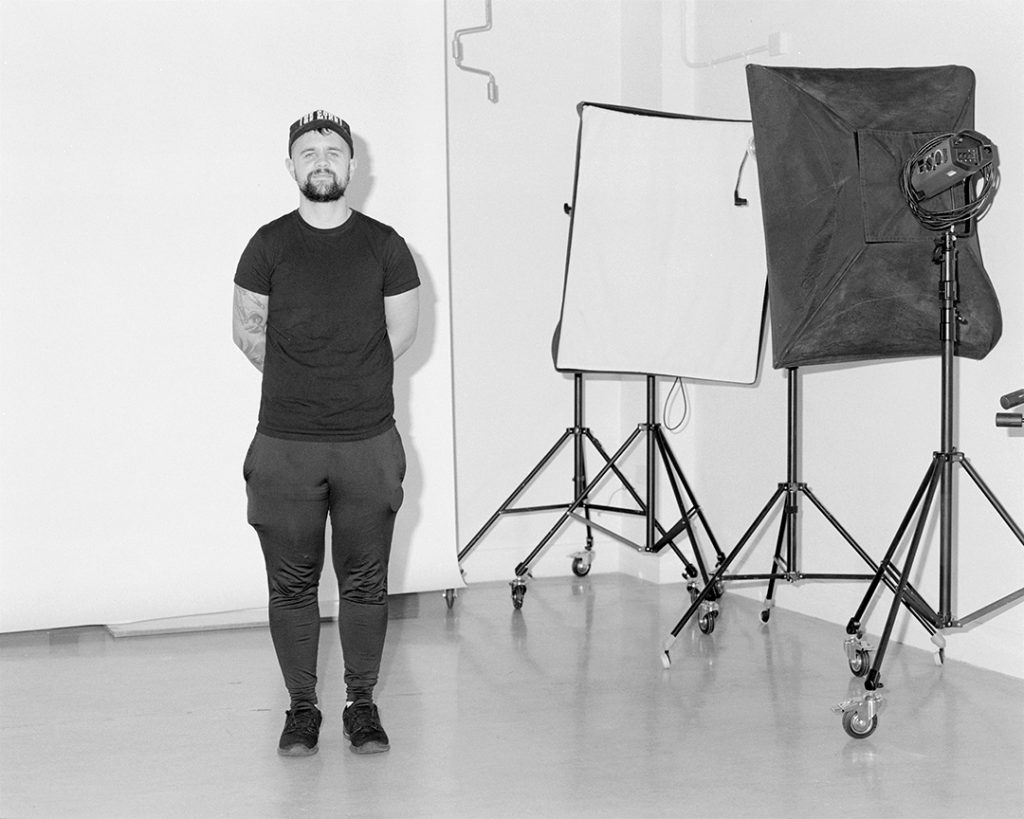
Flash: f8 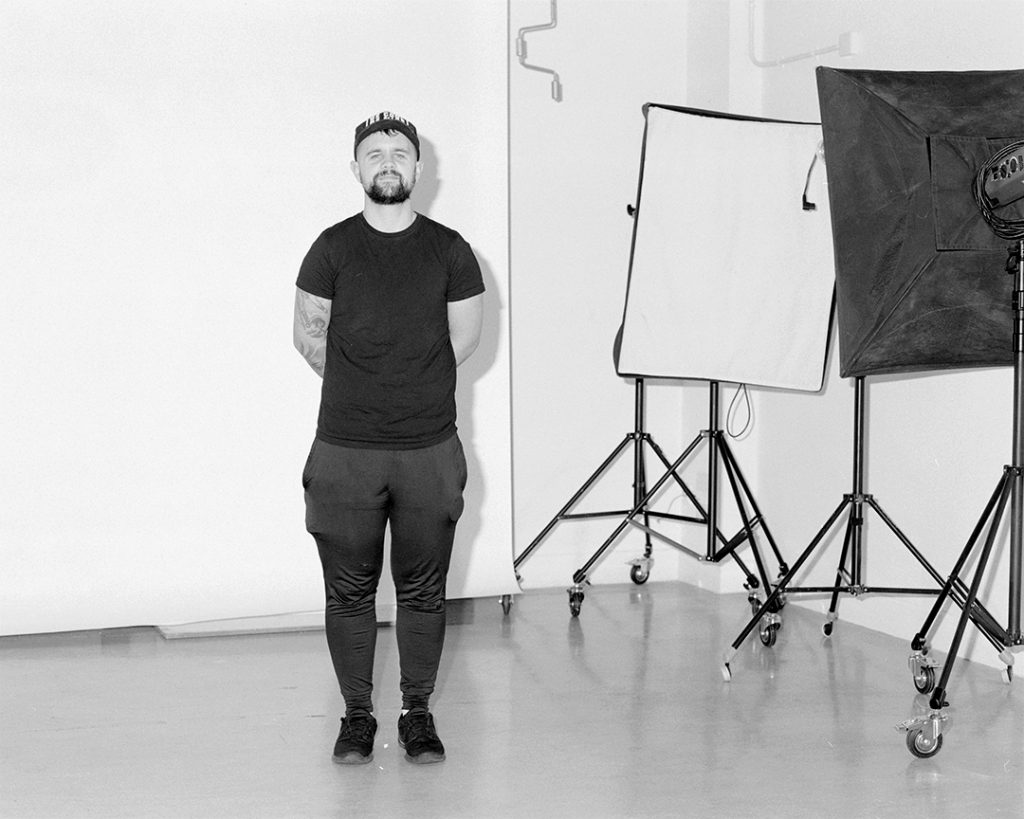
Flash: f11 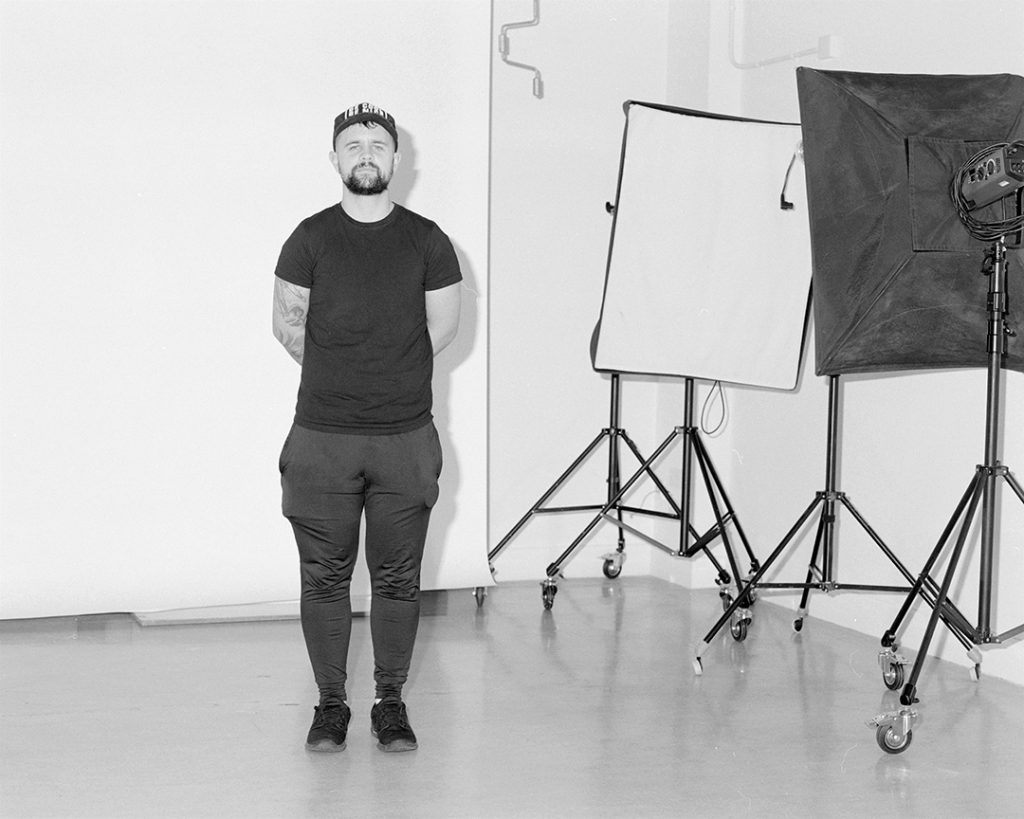
Flash: f16
For this second test shoot I have decided to keep the lens aperture the same for every shot. Instead of following the graph on top of the Metz I decided to put a roll through with every different flash brightness, just so I could visualise what was happening with the different flash levels. Each image was shot with f.8 on the lens and a 250th shutter speed.
10/2/20
Graphics Design & Promotional Material
I put forward to the group the suggestion of commissioning and collaborating with Max Wilkins, a 3rd year Graphic Design student, to create our personal branding for our degree show. I thought this would be a better idea than us making our logo’s etc, as it is his speciality and he could make a more consistent look across all of our assets: Logo, Instagram, Publication, Exhibition Plan Map, Poster, Business cards and Postcards.
In addition to this I was made aware to a company called MOO, through an Instagram advert (proof that targeted ads work!). They seem to be an extremely premium printing company in producing stickers, postcards, posters and business cards. They are slightly more pricy than other companies but it seems, from reviews, that the price difference is obvious in the final product and seems to be worth the extra cost.
Because of this increased cost on promotional material we are aware that extra fundraisers are needed to cover costs and also the cost of hiring Max to work for us.
The group where agreeable with these options I brought forward.
7/2/20
Katy Hundertmark Guest Lecture
As part of Futures festival Katy Hundertmark came to our university to give a guest lecture about her own personal practice and also her roll that she plays within the photography journal called Notes.
Katy is based in Edinburgh so as she was telling us her story on her personal progression and different organisations that have supported her/ she has worked with, they were mainly Scottish based which suits me for post graduate plans as I’m planning on moving back home to Ayr, South West Scotland.
One organisation that she mentioned was called Talk See Photography. These are hour long events, held monthly hosted at CCA in Glasgow. The idea behind these talks are to continue the conversations held whilst under the umbrella of further education post graduating. They are usually held by one or two photographers in focus where they will introduce their work and talk through it, then there is a section for Q&A afterwards. These will be extremely useful for me to attend as a source of inspiration, to keep my pulse on current contemporary work being created, and to further network myself and to try connect with others.
In addition to these standard talks, Talk See Photography also run an event called the Incubator Series. This is an open call series for emerging photographers to get the chance to talk about there work with an industry professional. This sounds absolutely perfect for further development of my own thinking and working post university and I will be definitely applying for this.
Katy Hundertmarck then went on to talk about her involvement with the journal Notes photography. This is a small bi-annual publication that she co edits. They have copies available and stocked in Streetlevel and Stills and other galleries. It was interesting to hear about what her roles entailed and to hear her opinion on interning for free as the project of notes started as a labour of love, with everyone working for free to try get the publication started.
4/2/20
Shooting Film with Flash
For my project I am intending on having very high contrast black and white prints, I’m wanting to do this to create a visually striking statement on the exhibition wall. This look will suit my subject as I’m wanting to work within a fishing village and community with the ultimate goal of going out on the boats with the men that work there.
In terms of getting the most contrast out of my images I have come up with 2 main ways of achieving this look. Shooting with a flash unit to isolate the subject in brighter light and have harsh fall offs of light to create a darker background, and by pushing my film in the developing process to create larger grain and compress the tonnes on the neg.
For the kit that I’m using:
:- My Mamiya RZ67 to shoot with for the extra quality gained with medium format film I can safely print my images large without a drop in quality.
:- Due to using the RZ67 the hotshoe mount is positioned on the side of the camera so traditional speed gun style flashes will not work in my shooting style. To solve this, I have been experimenting with a Metz Flash. The benefits of using this flash is that it mounts externally through ¼ wit worth screw into the tripod mount of the camera. This is important to me as mobility is an important factor.
Here are examples from a test shoot of shooting in accordance to the distance exposer graph on top of the Metz.
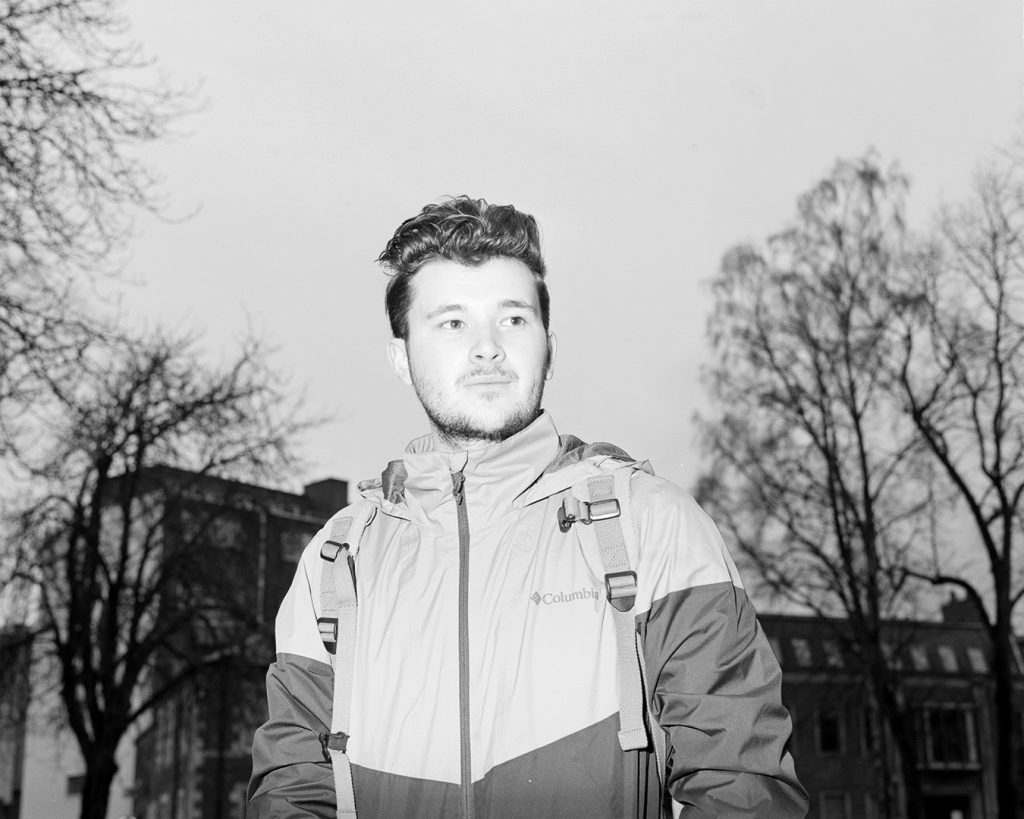
And a shot of the same film pushed to 1600 metered with an eternal meter.
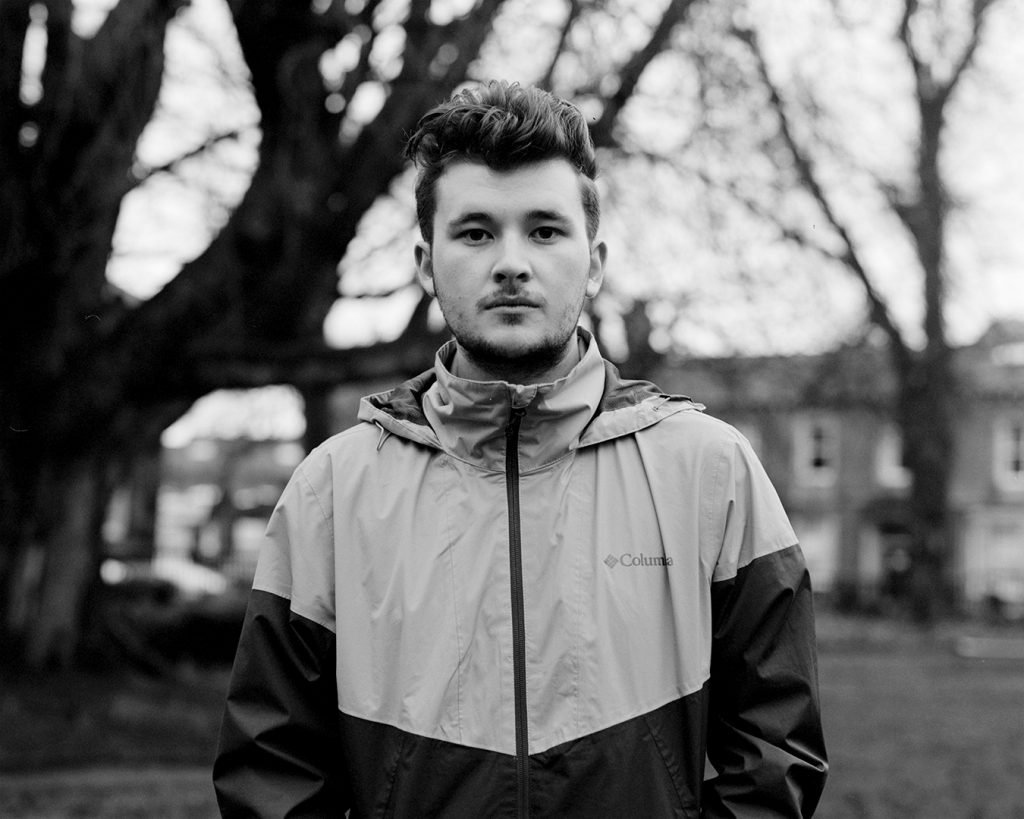
31/1/20
Oscar Marzaroll Exhibition
Today I visited the Oscar Marzaroll retrospective exhibition at Street Level, Glasgow. Here a few observations that I have made a noted down in relation to my own degree show planning.
:- All of the images in the show where archival pigment prints. This means that all of the negatives have been scanned and digitally printed, rather that the show being made up of entirely silver gelatine hand prints. This means that the show was cheaper and less time consuming to produce and install. Worth considering.
:- They made use of a large vinyl print stuck to the wall and then continued to hang the framed images over the top of this. I have in fact seen this technique cropping up more and more recently from exhibitions I have visited. From this I can conclude that this is quite a strong trend for galleries at the moment. Visually striking and makes the viewers attracted to that wall from afar and helps exhibition flow.
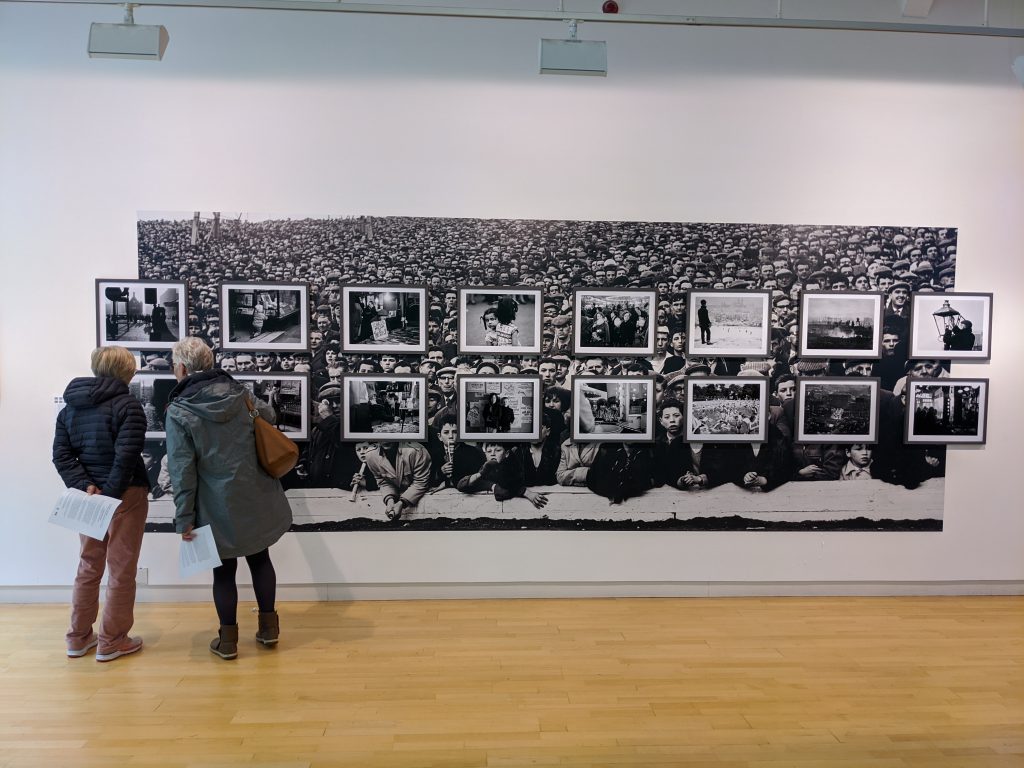
:- In the shop Street Level were selling prints of the works where there were two options available. Silver Gelatine or archival pigment print. One thing that I noticed in the difference between these two options (other than the price), was the framing methods used. Whilst very similar these differences where noticeable. The archival digital print was pressed flat against the frame, with a printed border on the paper the aesthetic look of a mount was achieved with print borders. This was not the same for the silver gelatine print which was framed more traditionally with a few mm thick in depth mount, I would think this also was to hold the print flat as it was a fibre print (an inherently curly paper), but it also served to off set the print from the glass which therefore means that there is no halo marks from the print being in direct contact with the glass.
:- The gallery has also painted a few of its traditionally white walls varied shades of blues and greens. For me, this feels like an attempt to cater to a contemporary market within the exhibition culture, whilst also honouring the more traditional approach with some documentary photography of Glasgow in the past.
:- Finally, as well as vinyl’s of some of the images on the wall, the gallery have also scanned in and blown up some of Marzaroll’s contact prints and stuck that on some of the less desirable areas for work in the gallery, (e.g. the more narrow passageway on approach to the shop.) This mot only filled an otherwise bare space on the wall, but it also gave us the viewers a further insight into the photographer’s mind by seeing other frames and compositions that he took.
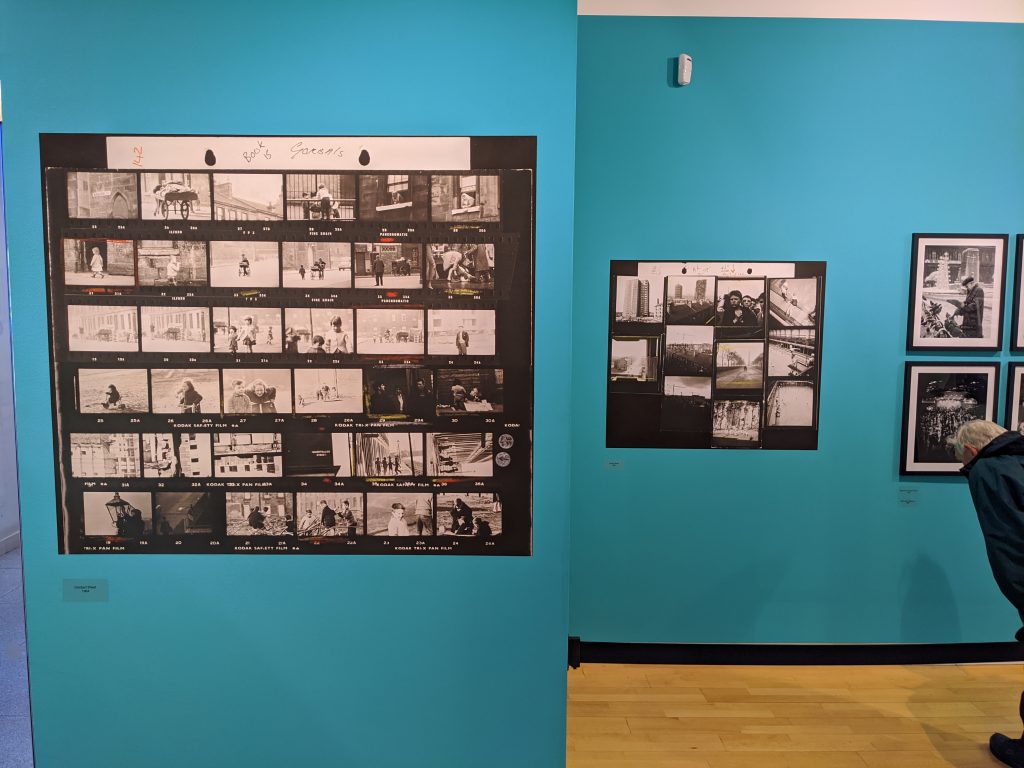
30/1/20
Instagram as a Form of Distribution
I’ve been researching and doing a lot of thinking into Instagram as a successful means of distribution/ exhibiting my work as a photographer. As the App was originally designed for photography and image sharing, you’d be under the impression that it is perfect for photographers for sharing their work with a wider audience, but I have found it very limiting for actual ‘useful’ expositor. I can not speak universally however, as I am very sure many people do find success through this platform, for me personally I do not find the interaction it encourages is beneficial for viewing projects and in-depth work on. Due to the nature of the app, users are encouraged to be continuously scrolling along their timeline, constantly digesting new and fresh content. Because of this people do not spend time with the images that they see on Instagram, I think you’d be lucky for someone to spend more than 10 seconds before ‘liking’ and moving on.
All of this being said, if there is a better way for interconnectedness I am yet to find it. Instagram is in everybody’s pockets, literally and therefore it is not to be over looked as an extremely effective networking tool. Especially within the creative industry, it is almost crucial to have an Instagram to swap with other practitioners you may meet as a way of keeping track of what the other person is up to and what they’re working on currently.
From this realisation that it is necessary to have an Instagram, this leaves the final question of what to upload? Because of my frustration of sharing work with an audience that’s expected to validate your work with ‘likes’ and to scroll on to the next thing, what would be a good alternative to upload to keep professionals updated of your personal progression? I think it’s all about balance and a mix of different elements. It is unavoidable to share your work, however I think it is just as effective to show ‘behind the scenes’ of your workflow. For example: photos or videos of the wider locations, production of the work (be it digital or analogue). By showing an insight into how you work you can quickly update people on what it is you’re working on and people can develop and invested interest into how the project can lie out from initial conception to final completion.
28/1/20
Successful Crowdfunding
I have started my research into the world of crowdfunding as this is going to be a viable route for some fundraising for our up and coming Degree Show. The two Styles of crowdfunding that are applicable to the funding of a degree show are: Reward based, or Donation. For a Reward style of funding what we will have to do as a group is come up with creative ideas of products we can ‘sell’ as part of the reward scheme. The idea behind having rewards is providing an incentive for people to consider going up to the next tier of reward for not much more to them, but that will add up for us allowing us to reach our goal. However, the other route we could take is leaning into the degree show being a not for profit event therefore relying on charitable donations to fund it.
The two biggest platforms for crowdfunding are Kickstarter and Indiegogo. The differences being that for Kickstarter, its all or nothing in terms of funds raised. If you do not reach the goal before the deadline then you see none of the money raised and it all gets returned to the donors, however with Indiegogo you can choose to pull out the money at any point in the goal timeline. Furthermore, Indiegogo embeds their videos from Youtube or Vimeo whereas Kickstarted hosts the videos itself, by embedding videos from Youtube there is the possibility of gaining extra traction from views and interaction from that website as well. However, for Kickstarter’s defence it has a larger brand name with wider recognition for what it is, therefore, possible backers instantly know what it is from the use of the hosting sites name. These are all points that will need to be discussed as a group and to weigh up which option we prefer.
On the topic of video, we will have to produce a video for the campaign page. This will have to tell the story of what it is we’re setting out to do. It should be 2 minuets long and tell potential backers within the first 15 seconds what the project is about. Once that is done then there is a bit more room to go into more detail about where the costs might go etc. The sense of place, setting and presenters are extremely important for this as it should feel relatable and engaging. An intimate video of one or two people addressing the camera straight on can achieve this sense of engagement effectively. The video should act as an introduction to the campaign page where the viewer can then read on to find out more and be introduced to more specifics, introduced to the whole team, etc.
The final part upon my research is within the distribution. Distribution is crucial to a successful crowdfunding. We as a group have the daunting task of raising awareness and building an audience willing to back the project through as many outlets as we can. These include social media, website, posters, flyers and local press. All of these will link hand in hand to build up enough traffic to our crowdfunding sight that I’m confident we can set a hearty goal to achieve.
26/01/20
Self Publishing
In 2020 it is rather easy to self-publish your own zine or photo book, and therefore granting the access to have your work seen in a book format as a physical medium, without having the gatekeeper of a publisher or external voice to prevent this. This being said, there are many ways of going about self-publishing that I myself am experimenting with at the moment.
Currently I am doing a limited run of books from work I made last year, that as part of the assessment process, we where expected to produce a book dummy. For my design I decided I wanted to make my book on newsprint, to emulate the feel of a newspaper, as this suited the subject matter of my work. I ran into a few problems as I was doing this however, the main one being that the newsprint I had sourced was too thin to go through our printers at university and kept being chewed up by the print head and not going through the rollers. I then did further research into different kinds of paper I could use that where thicker than the newsprint I had, but still had the tactile feeling of a newspaper when held. My solution to this problem was recycled sugar paper. With its 100gsm weight it was able to be successfully loaded and printed on and due to its size (A2), it had to be loaded by hand each sheet individually into our Epson sure colour p9000, which capacitates up to B0 rolls of paper.
Now the problems I have incurred from printing my book this way, is how to make it profitable to sell. The problem being how long each book takes me to make and how much the raw materials cost all added together. The only perceivable solution to this is to raise the cost.
I’m currently sat writing this upon my fourth day straight printing all day to finish this run of books reflecting upon this process and how realistically, this is not a sustainable process. The entire process is so time consuming and because of having to get up and change the sheet of paper in the printer every 6 minutes, does not leave me time to be focused on doing another meaningful task simultaneously. From further research and recommendations from tutors from different courses and outside artist talks, I have found a company called Newspaper Club that print on newsprint and do large orders with an extremely fast turnaround. Upon discovering and researching into this company this has sparked an interest for me to use them for my next self-publication, as this will allow me to have a more hands off approach to the production (I will still be designing the zine however) which therefore frees up time to be creating other things, or more accurately be designing and putting up my degree show! Furthermore, by outsourcing the production to an external company for printing and paper I can keep the cost per unit down. The only downside of going through Newspaper Club is that the final product will feel less exclusive to the touch than my hand made book, but what you lose in physical quality and paper weight, you gain in mass production.
16/1/20
Process lead development
The themes and motifs for Fences Make Neighbours has come about through reflection and process lead development. This project has been in development for 4 months of intense shooting, image making and reflection.
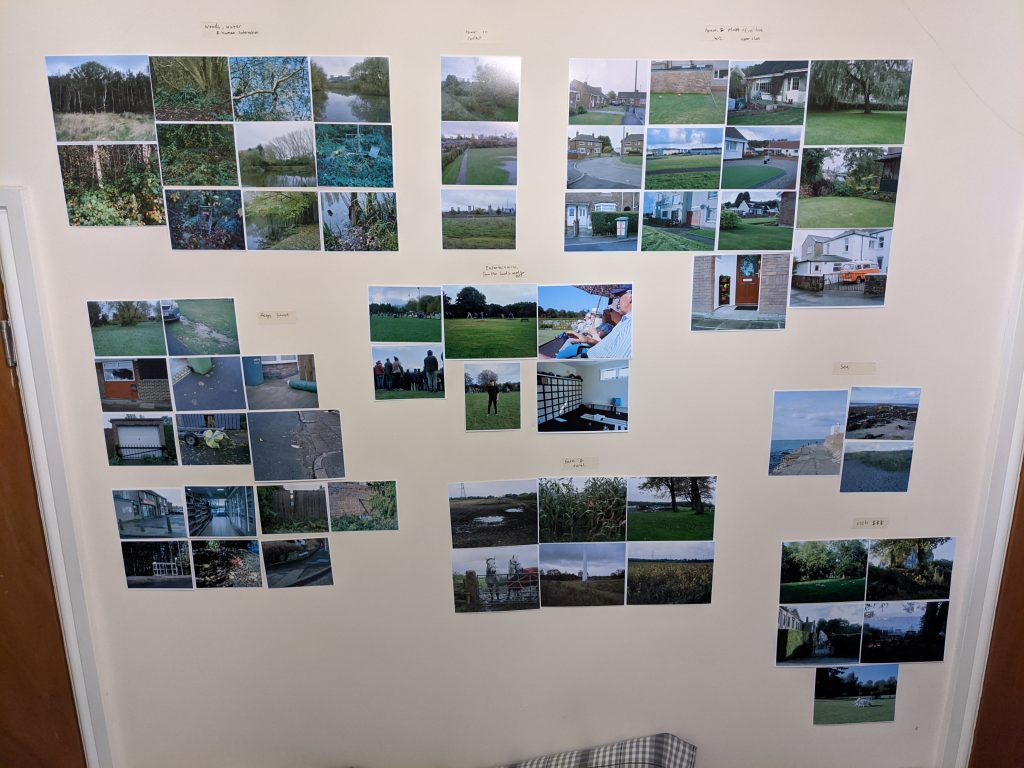
This is an important part of the reflection process, making working prints and sticking them on a wall is an incredible way of visualising groupings and natural themes developing. As we can see here there is two main strands of though developing. Residential focus and humans influence of outskirt areas.
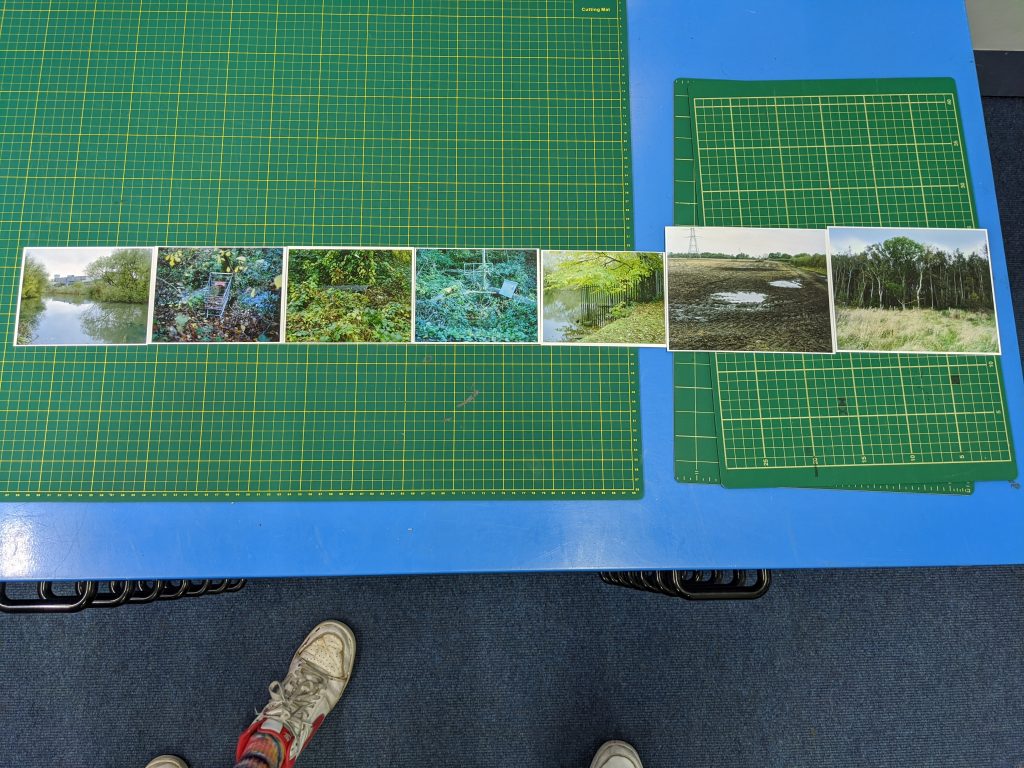
Here is an example of a sequence of images, focused around liminal spaces that I had identified as a potential focus to the project. However, I ultimately decided against this in favour of residential areas.
The process of theme development through practice has proved challenging in some aspects, and freeing in others. This is because, with projects responding to briefs, they give you a clear focus in fields such as, where to photograph, or how to, or what the subject is. However this can also sometimes feel quite restrictive. By finding the projects feet through reviewing and reflecting, I have removed the feelings of restriction associated with responsive work, but in contrast this has felt quite intimidating at times to naturally let the work develop.
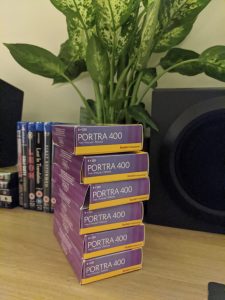
Here we see the volume of film that I shot for this project, because of the unclear trajectory of the project an awful lot of images where taken and then a large refined edit was taken afterwards.
Interestingly enough, one location I was exploring during the production of the work was an old football ground in Billingham. Upon first discovering the building in June there still stood an old abandoned stand for seating and changing rooms for the players etc, however when i came to photograph again 4 months later the whole place had been demolished revealing a view of the industry behind the pitch.
13/12/19
